
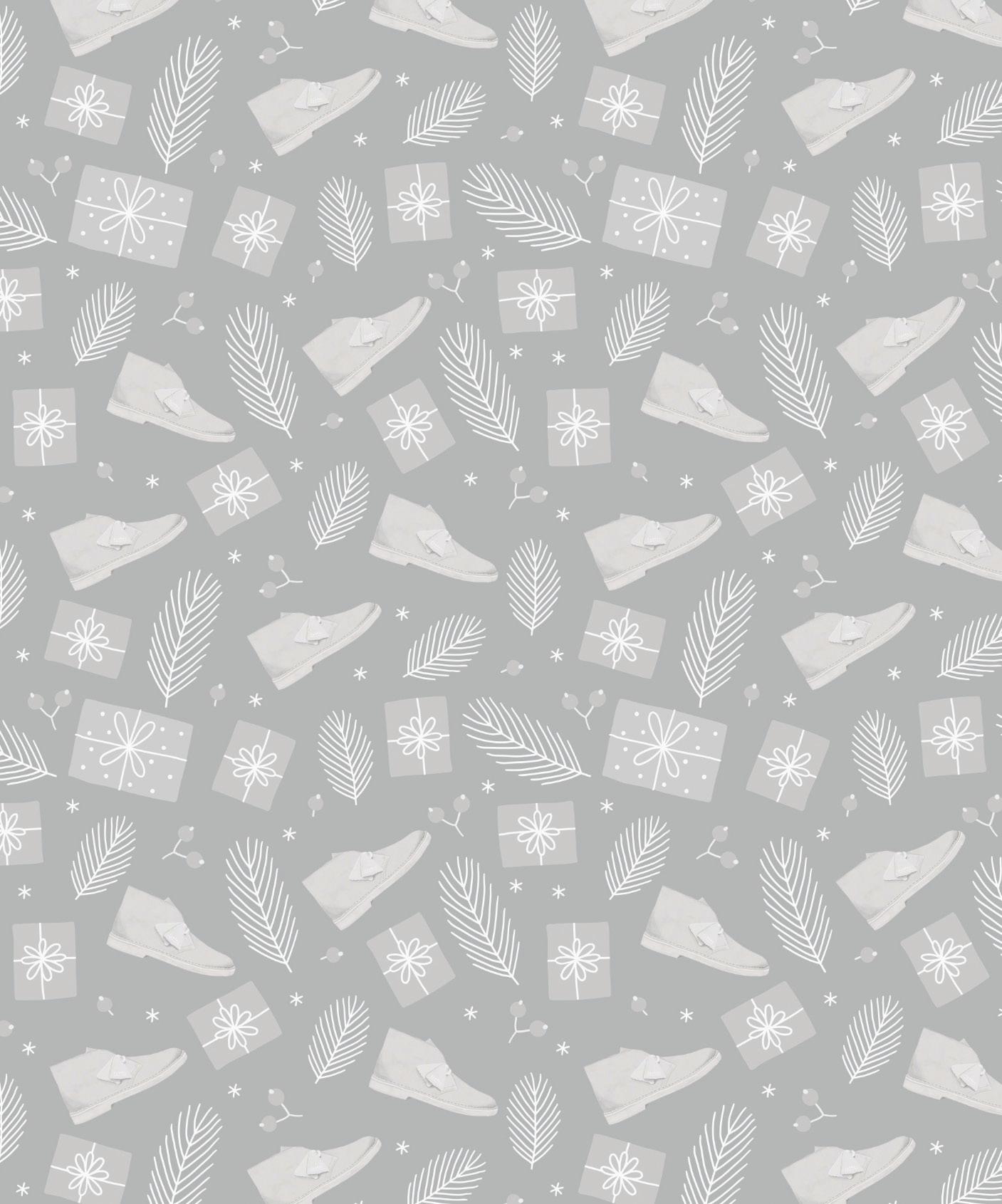

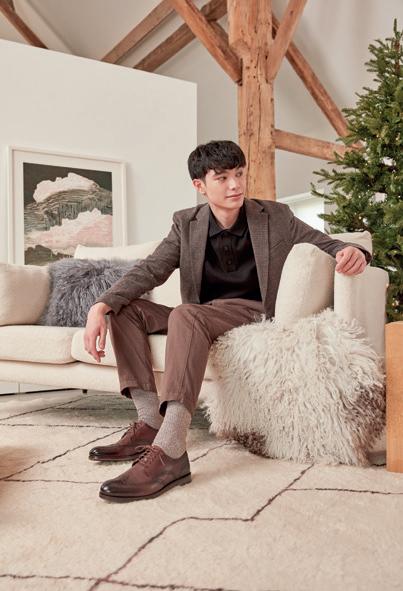



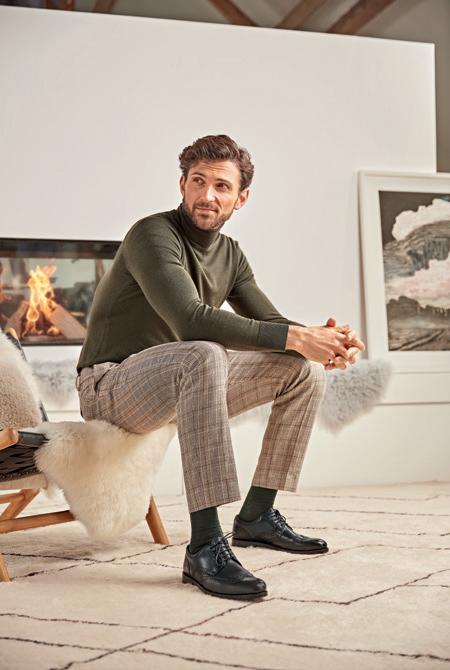
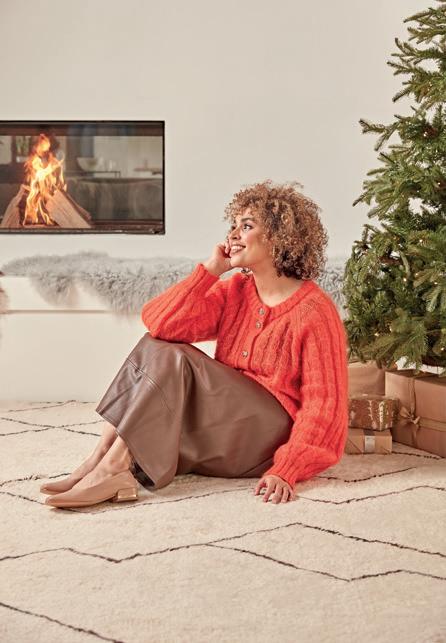









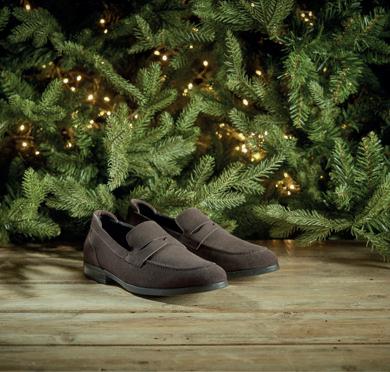

 Clarks and the Clarks logo are registered trade marks of C. & J. Clark International Limited.
Clarks and the Clarks logo are registered trade marks of C. & J. Clark International Limited.


On
Photography by Trevett McCandlliss; styling by Nancy Campbell; fashion editor: Kathleen O’Reilly; model: Migle/Q Model Mgmt.; digital tech: Marco Scozzaro; first assistant: William Eadon; photo assistant: Raymond Collette; makeup: Maya Ling Feero; hair: Vera Koumbiadis; styling/production assistant: Sarah Frey.
Tom Berry, president/CEO of Ecco Americas, on why the Danish brand views today’s modern family as pure gold.
By Greg Dutter 16 Chukka Can! An oasis of eternal cool, casual style, the Clarks Desert Boot enters our esteemed Style Hall of Fame.
By Greg Dutter
24 Look, Mom! No Laces! Designers put a fresh spin on men’s loafers.
By Kathleen O’Reilly 26 That ’70s Shoe Beep, beep! Chunky, funky platforms top the charts again this spring.

By Kathleen O’Reilly
Belinda Pina Publisher
Greg Dutter Editorial Director
Nancy Campbell Trevett McCandliss Creative Directors
EDITORIAL
Kathy Passero Editor at Large
Kathleen O’Reilly Fashion Editor
Melodie Jeng Marcy Swingle
Contributing Photographers
ADVERTISING/ PRODUCTION
Noelle Heffernan
Senior Account Manager
Laurie Guptill Production Manager
Kathy Wenzler Circulation Director Catherine Rosario Office Manager
Mike Hoff Digital Director
WAINSCOT MEDIA
Carroll Dowden Chairman Mark Dowden President & CEO
Steven J. Resnick Vice President & CFO
OFFICES
ADVERTISING/EDITORIAL
One Maynard Drive
Park Ridge, NJ 07656
Tel: (201) 571-2244
Advertising: Belinda. Pina@Wainscotmedia.com
Editorial: Greg.Dutter@ Wainscotmedia.com
CIRCULATION
One Maynard Drive Park Ridge, NJ 07656
Tel: (201) 571-2244 Circ@Wainscotmedia.com
2 footwearplusmagazine.com • december 2022 PAGE 26 4 Editor’s Note 6 This Just In: Sydney 8 Scene & Heard 20 A Note to My Younger Self 22 Trend Spotting: Flats 23 Trend Spotting: Slingbacks 38 Shoe Salon 40 Last Shot
10 A Real Gem
FEATURES DEPARTMENTS
cover: Qupid sculpted heel platform sandals.
FOOTWEAR PLUS ™ (ISSN#1054-898X) The fashion magazine of the footwear industry is published monthly (except for bimonthly April/May and October/November editions) by Wainscot Media, One Maynard Drive, Park Ridge, NJ, 07656. The publishers of this magazine do not accept responsibility for statements made by their advertisers in business competition. Periodicals postage paid at Mahwah, NJ, and additional mailing offices. Subscription price for one year: $48 in the U.S. Rates outside the U.S. are available upon request. Single copy price: $10.
Send address changes to FOOTWEAR PLUS, P.O. Box 8548, Lowell, MA 01853-8548. Publisher not responsible for unsolicited articles or photos. Any photographs, artwork, manuscripts, editorial samples or merchandise sent for editorial consideration are sent at the sole risk of the sender. Wainscot Media will assume no responsibility for loss or damage. No portion of this issue may be reproduced without the written permission of the publisher. ©2008 by Wainscot Media. Printed in the United States.
POSTMASTER:
From top: Vagabond ankle strap sandal; chunky platform by Seychelles DECEMBER 2022
All Season Comfort

orders@propetfootwear.com 800-877-6738
Markers
Reporter’s Notebook
RECENTLY, SOMEONE ASKED me what I did for a living and I replied, “I’m an editor.” I didn’t bother to mention my official title of Editorial Director because often when people hear the latter word, they ask if I’m involved in the movie business. By the time I explain that I write for a trade magazine covering the footwear industry, their eyes have usually glazed over.
Fortunately, I don’t have to win this audience over about our amazing industry. Our readers are all Shoe Dogs of varying breeds and degrees, hungry for the latest trends, news and analysis. And that all starts by asking questions to get the answers I need to write the stories featured in these pages. I’ve been following that basic journalistic approach since day one, which, for me, began more than 30 years ago as a reporter for the News-Record of Maplewood and South Orange. Back then I didn’t know squat about esoteric zoning laws, Shakespearean school board machinations, contentious town council proceedings, etc., etc. So, I asked a lot of questions before ever putting fingers to keyboard. And I’ve asked and asked all kinds of questions in covering the shoe biz because, even after more than two decades, no matter how much I’ve learned, I’d never profess to know how to run a global shoe empire. Nor do I have the skills to manage a retail business. My math incompetence alone would rule me out of consideration for either position.
In the pursuit of accuracy, I regularly ask so-called “stupid” questions. The answers can lead a story in an unexpected and important direction. Case in point: During my first month as a reporter, I attended a press briefing after a police officer was shot and nearly killed responding to a home robbery. The responding EMT was the officer’s wife, though she didn’t know the victim’s identity until she arrived on the scene. It was a big story. Sitting alongside a row of TV news personalities in attendance, I was content to learn how the pros did it. But as the event wore on, a question no one was asking nagged at me. Had I missed the obvious? If I dared ask, would I be exposed as a stupid cub reporter? Finally, I timidly raised my hand and asked the police chief, “Whose gun was it?” He sighed, gave me a you-had-to-ask-that-question look, and answered: It was the officer’s. He had lost it in a struggle with the suspect, who was still at large and armed. The entire tone of the press conference flipped immediately and press row started firing all sorts of questions.
My big picture takeaway: Always ask questions. Ask the standard who, what, when, where, how and why. Ask follow-up questions to get more detail and ask clarification questions to get it right. And whenever you have the opportunity to ask an expert and/or the person in charge, do it!
My favorite questions to ask, though, are Proustian in nature. Not only do they break the ice but the responses often reveal interesting anecdotes about a subject. Asking, for example, what someone’s favorite home town memory is, their least favorite word and their motto can reveal so much about them. The same is true of what they are currently reading. Tom Berry, president and CEO of Ecco Americas and the subject of this issue’s Q&A (p. 10), for example, is reading The Daily Stoic. In addition, Polish Boy sandwiches are his favorite Cleveland hometown memory, he loathes the word “lazy” and the former Army Infantry Officer’s motto is: FIDO (forget it, drive on). The answers to those four simple questions painted an intriguing portrait. Berry’s responses to my other questions tell an insightful, detailed and candid story about the Danish brand’s aims to meet the needs of today’s modern family, which he believes offers an enormous growth opportunity. It too is a big story.
Another big story (p. 8) recaps Dr. D’Wayne Edwards successful efforts this year as founder of the newly opened Pensole Lewis College of Business & Design in Detroit. This past spring the first-ever Historically Black College or University (HBCU) dedicated to design welcomed its inaugural class, and this fall it hosted the in-person return of the Black Footwear Forum, which drew 500 industry members. Edwards, the renowned former Nike designer, is an industry visionary on many fronts. I could ask him questions all day, about any topic, and be inspired to write. In a world gone mad/sad, he’s a welcome light.
Finally, there’s the huge story of the latest induction into the Footwear Plus Style Hall of Fame, the Clarks Desert Boot. The iconic style is our 34th inductee. Over the past 15 years, we’ve covered each newcomer to the Hall of Fame, asking questions to help get to the heart of what makes a style unique and compelling enough to remain relevant for decades. The answers are always fascinating. In the case of the Desert Boot, which Clarks officially launched in 1950, its roots date back 1,000 years to the remote Kalahari Desert region of Africa. What an epic journey this epitome of effortless casual style has enjoyed. If only this Clarks Desert Boot could talk, I’d ask it all sorts of questions!
Greg Dutter Editorial Director

4 footwearplusmagazine.com • december 2022 EDITOR’S NOTE Question


You
sole .
have a beautiful
BEAUTIISOLES.com • IG: @BEAUTIISOLES
Linda Pettinato linda@beautiisoles.com
Aussie Rules
Chelsea boots are de rigueur Down Under. Photography by Giuseppe Santamaria










6 footwearplusmagazine.com • december 2022
THIS JUST IN
SUSTAINABLE STYLE


OrthoLite® HybridPlus-Recycled™ provides the unprecedented ability to elevate the eco-content of your insoles to 50%. Uniquely blending 7% recycled rubber powder and 43% recycled PU foam achieves 50% recycled content. OrthoLite adds sustainable comfort your consumers expect with a eco-friendly feature they demand.
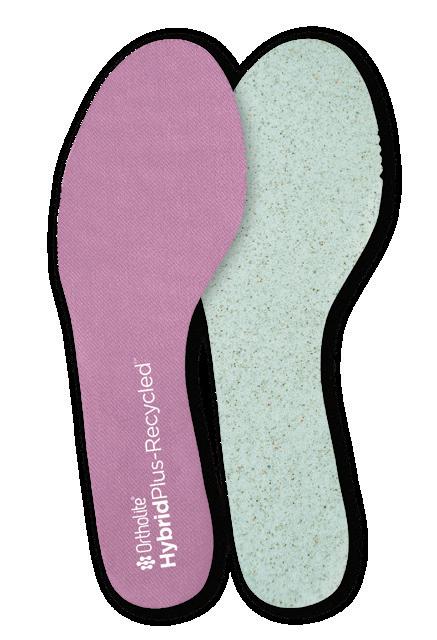
PLC Founder Dr. D’Wayne Edwards Savors a Very Good Year
FROM THE OPENING of the Pensole Lewis College of Business & Design (PLC) to the in-person return of Black Footwear Forum (BFF), 2022 was a very good year for Dr. D’Wayne Edwards, PLC founder and host of the BFF. Both in Detroit, PLC welcomed its inaugural class of 31 aspiring design students in early May, while the BFF, in partner ship with the FDRA, saw more than 500 industry leaders and aspiring professionals meet over three days in mid-September at the school for networking and community outreach events. Edwards’ year was also highlighted by the soft opening, in partnership with Designer Brands, of the first black-owned U.S. footwear factory, JEMS by Pensole, that will soon feature designs by PLC students sold at DSW stores.
Looking back on a busy and successful year, Edwards sums it up in a word: humbling. “I never dreamed this big before,” the renowned former Nike designer says, adding that the support of his team and supporters made it all possible. “What we’re trying to achieve has a much bigger purpose and impact that will last beyond our time here on Earth.”
Edwards recalls many highlights throughout 2022, but the big gest was the reopening of PLC, Michigan’s first and only Historically Black College or University (HBCU) and only such institution focused on design. “Detroit and the foot wear industry have supported us both financially and emotionally,” he says. “It’s one thing to have a vision, but when people run with that and make it bigger than what you originally envisioned is a whole other level.” Edwards believes PLC and BFF will only get bigger and better in the years ahead.
Like, for example, BFF again holding its event at PLC’s new Detroit digs. Edwards says the industry members who saw what PLC is doing served as an aha moment. “It really clicked for a lot of attendees, especially those who’ve known us since our Pensole Design School days in Portland,” he says. “To see the difference in what we’re doing now in Detroit was huge. Layer on that the fellowship and togetherness that BFF has always brought, and that brought everything to next level status.”
A BFF highlight was the downtown pop-up lounge created in part nership with sneaker reseller, StockX. Designed to showcase PLC to the community, the space featured a Kicks magazine tribute to Black designers whose shoes have graced its covers the past 25 years. In addi tion, Champion powered an art showcase and panel discussion with Detroit artists, and BFF hosted “Kids Are Ready for Design” that saw 200-plus middle schoolers attend a panel discussion led by award-winning designer, entrepreneur and educator, Jason Mayden. “These kids have seen the shoes these designers have created, but probably never knew that the people looked like them,” Edwards says.
This year’s BFF was titled “Homecoming,” which played on PLC’s campus setting that enabled attendees to reconnect, celebrate, educate, inspire and recognize Black creatives working in the industry. It kicked off with a conversation with Terrence Floyd, brother of George Floyd, who was murdered by a Minneapolis police officer exactly 845 days prior. Edwards believes that set the tone for BFF. “I explained to Terrence that his brother didn’t die in vain,” he says. “That the majority of the audience would have never been in or would have taken them a whole lot longer to be in the industry thanks to the $50 billion in corporate pledges made since. We wanted to make sure that he understood that his family has impacted an entire industry that will always remember that.”
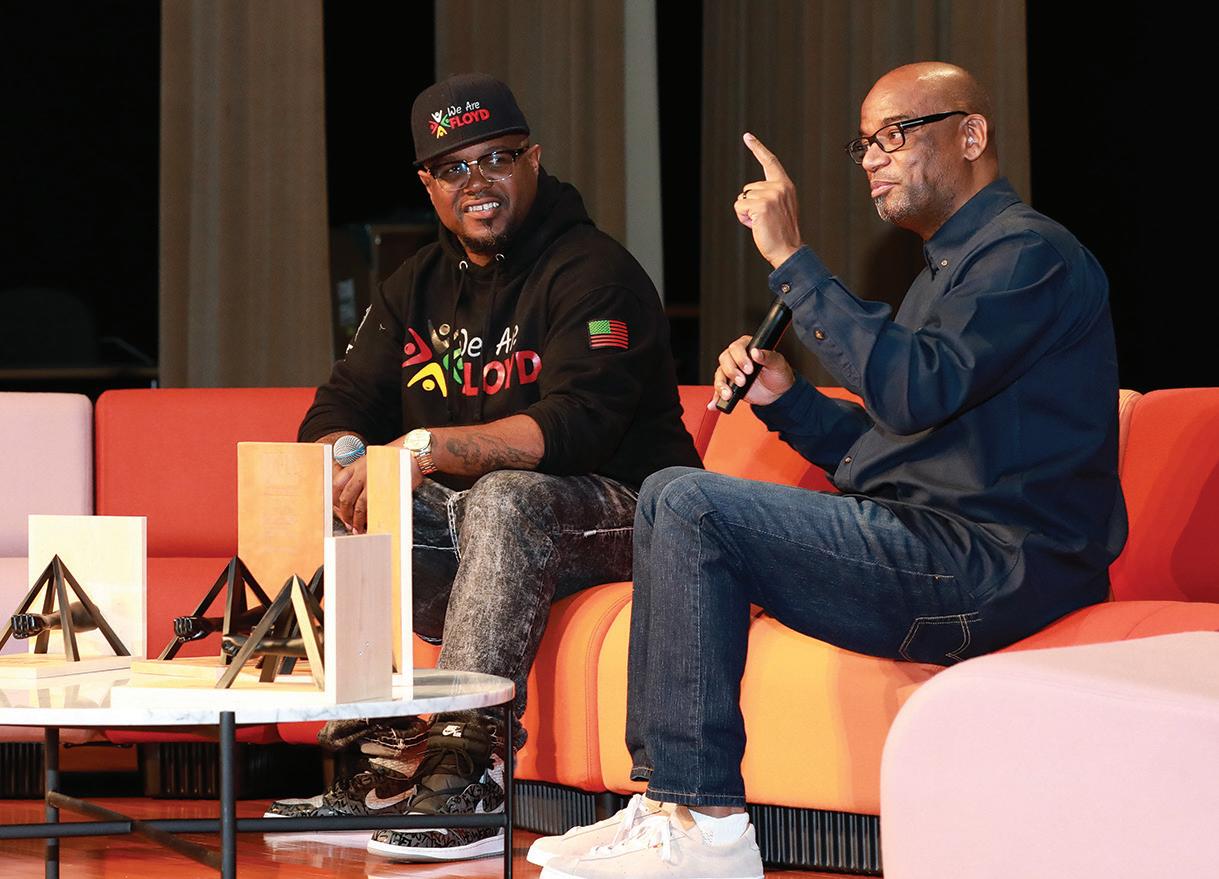
On that note, Edwards is moving full steam ahead on PLC and BFF plans for 2023 and beyond. There will be more PLC classes sponsored by leading brands and the BFF next summer (date TBD) will feature an in-depth slate, including professional development services; more activa tions for women, high school and college students; and a possible CEO summit. “BFF has an opportunity to really grow beyond a forum and have a generational impact on kids trying to get into the industry as well as help elevate those who are already in it,” Edwards says.
With regards to PLC, Edwards sees the school as on the cutting edge of design education. Rather than the traditional—and quite expensive—four-year college route, he believes PLC’s approach is more affordable and in line with what many corporations are seeking today. “We’re creating new educa tional methods that give students the exact knowledge they need to be employable,” he explains, noting the focus is on credential programs co-created and certified by industry companies. “Having, for example, certified credentials from Nike versus a four-year degree from some college is more attractive to employers.” Edwards adds, “We consider PLC to be the industry’s college.”
Taking stock on 2022, Edwards says there were plenty of challenges but most were overcome. Regardless, he refused to get bogged down by dwelling on the negatives. “Things didn’t always go as planned, but I used that as motivation to keep moving forward,” Edwards says, not ing that education is a “show me” industry. “PLC is my ultimate design assignment: Taking all these ideas in my head and building a team to bring it to life. We came a long way in 2022.”
In fact, Edwards’ goal back in 2011, when he left his design career behind to pursue education full-time, was for people to “forget I ever designed shoes.” Mission being accomplished, as he is receiving far greater recognition for his educational efforts and accomplishments. “It means I’m doing something way more important in this chapter of my life than I did in my first chapter,” Edwards says.
8 footwearplusmagazine.com • december 2022 SCENE & HEARD
Terrence Floyd, brother of George Floyd, and Dr. Dwayne Edwards (right) opened the recent Black Footwear Forum in Detroit.
IR Show Readying to Set Sail in Mid-January
WHEN IN SAN DIEGO…enjoy the SoCal city’s beautiful weather, especially in mid-January when much of the nation is shivering. That ace up the IR Show’s sleeve will be even stronger as the event (Jan. 17-19) moves to new digs inside the San Diego Convention Center. The Sails Pavilion is a glass-enclosed space with high ceilings that leads out to a waterfront terrace that will host the Mix ’N Mingle cocktail party on opening night.

It’s all about providing a great experience, says Show Director Gary Hauss. Do that well and people will come, he believes. “People like having fun!” Hauss says. “San Diego is a great entertainment des tination—it offers ease and affordability of travel, incredible weather and nearby hotel and restaurants. And while our event space is large, it’s set up in a way that feels cozy and is easy to navigate.”
With two shows under his belt, Hauss feels IR is already a strong West Coast show. That growth is even more impressive taking into consideration when it debuted. “We opened in the middle of the Omicron outbreak, complete with Covid officers and an onsite nurse,” Hauss says. “So, our growth has been great. There’s been a lot of posi tive word of mouth—many new brands have heard about us from reps or retailers who’ve told them that they have to be at the IR Show.” It remains a growth in progress. “To become a long-term success, we need to stay grounded and focus on providing great customer service for vendors and retailers, and keep the show relevant, interesting and, of course, fun,” he says.
Hauss says attendees can expect educational seminars, networking opportunities and lots of free snacks (think popcorn, soft pretzels and warm cookies). Opening night will feature Conversation Over Cocktails with the leadership teams of Larry, Matt and Evan Schwartz of Aetrex and Justin Kehrwald and Kim McKeown of Tradehome Shoes, the 130 store-plus Midwest chain. Day two will kick off with a marketing seminar spon sored by USRA and Omni. “We’re upping our educational events to make sure they are entertaining, educational and experiential,” he says.
Hauss says buyers can expect more exhibitors, rep resenting a broader market breadth. “We’ve added more fashion and men’s brands, and we’ve also added a kids’ section,” he says. As for buyer attendance, Hauss is expect ing to exceed the amount seen at the February show that saw retailers from 23 states and a few countries.
Hauss expects continued growth for IR in the years ahead, so long as it adheres to its mission to bring the industry together twice annually. It’s economically imperative for vendors to see many accounts in one place, and retailers need to see their staples as well as new brands, he says. “The IR Show is a place where old friends can meet and new ones can connect,” Hauss says. “It’s a place where people will look forward to signing up for the next show, which is July 28-30, 2023.”
Rack Room Shoes Supports Veterans
HOME IS WHERE these heroes live. Rack Room Shoes, celebrat ing its 100th anniversary this year, is continuing its long partnership with Military Makeover with Montel, the Lifetime Network home improvement series that performs home makeovers for disabled veterans. The latest hero to receive a makeover is Jonathan Thomas, his wife, Natasha, and their four children.

While the show’s national brand partners renovated the Thomas’ home, upgrading its HVAC system and installing new cabinets, elec tronics and furniture, the Charlotte, NC-based Rack Room Shoes chain hosted the family for a once-in-a-lifetime shopping spree at its Indian Land, SC, store.
“We truly value the sacrifice and service of our veterans,” states Mark Lardie, CEO of Rack Room Shoes. “It is an honor to recognize the Thomas family through our partnership with Military Makeover. I was pleased to meet the Thomas family and was touched they enjoyed their shopping trip to Rack Room Shoes.”
“We have enjoyed working with Rack Room Shoes on Military Makeover, now for the fourth time,” says Scott Moss, EVP of pro gramming/president, BrandStar Entertainment and creators of the series. “They are a wonderful company dedicated to improving our community, and there’s no doubt the Thomas family will think of them every time they walk out the door.”
Thomas enlisted in the Army National Guard in 2001. In 2008, after being deployed twice to Iraq and Afghanistan, he was blown out of a guard tower by a suicide bomber. His actions resulted in saving the entire unit’s lives by taking the blast full force, which left him with a severe spinal injury and peripheral damage in his right eye. Thomas received two Purple Hearts for his acts of valor and for the injuries he sustained. He was also awarded a Bronze Star for heroism and the lives he saved that day. In 2012, Thomas became an instructor at Fort Benning, GA. His 16-year military career ended after he was diagnosed with cancer. However, he continues to move forward in life and still feels a calling to help others.
The show runs in syndication on the American Forces TV Network, and is available 24 hours a day on miltarymakeover.tv.
2022 december • footwearplusmagazine.com 9 SCENE & HEARD
The IR Show‘s adjacent terrace, where it’s always sunny in San Diego.
Q&A
BY GREG DUTTER
A REAL GEM
TOM BERRY IS a storyteller at heart, and over the course of his career he’s had the opportunity to help tell some great brand stories. They include The North Face, Salomon, Tecnica, Hoka and, most recently, Levi Strauss & Co. Those are market leaders dripping with heritage and renowned for product innovation. Berry says Ecco is no different. In fact, the exec believes the story the team is creating is equally compelling, not to mention timely in a largely sneaker-wearing landscape. That’s because Berry firmly believes the great style pendulum is beginning to swing back to a comfort casual middle (think brown shoes), and the opportunity to seize upon this macro shift is there for the taking—provided Ecco tells its unique “farm-to-foot” story well.

“This brand has all the right ingredients,” Berry says, describing it as a hidden gem. “We have a great values proposition, a unique vertical supply chain and the ability to deliver the right solutions to consumers increasingly looking for hybrid, sustainable product.”
Berry believes Ecco’s farm-to-foot capabilities (meaning it owns its tanneries and factories) put it in a unique and enviable position. “It gives us huge advantages when it comes to transparency with regard to environmental and social responsibility,” he explains. “It also gives us tremendous agility advantages.”
Tom Berry, president and CEO of Ecco Americas, on how the Danish brand’s intrinsic qualities serve as a beacon for today’s modern family. tunity, according to Berry. As those brands have become more lifestyle-driven in styling over the past few years, he believes a vast middle ground has opened that Ecco has every right to compete in. “While we’re never going to make the best basketball shoe, when it comes to everyday hybrid solutions, our shoes are as good or better than anything in the marketplace,” he says. “We’ve got giant advantages when it comes to durability, support and sustainability versus many of the athletic guys.”
The fact is consumers increasingly want to buy brands that do right by people and the planet. Ecco has an extensive track record of doing just that for more than 50 years. Its values-driven platform isn’t a new marketing ploy. Of course, sustainably manufactured product by decent people only goes so far. The shoes must deliver on comfort, durability, quality and style. The first three are consumer expectations, and ones that Ecco has proven it provides. The latter has always been more of a crapshoot. It’s just that now Berry believes the odds are in Ecco’s favor. “Lots of people are wearing shoes 95 percent of the time designed for the five percent of the time they may be running,” he offers. “The reality is people are standing, walking, taking their kids to practice, etc., and they need great, everyday comfort and performance, but in a dress-casual aesthetic.” Berry adds, “Consumers are looking for choice, and I think they’re going to pivot hard toward this segment.”
Athletic brands have actually helped set the stage for this oppor
That’s true provided people hear the Ecco, so to speak. To seize the opportunity, Ecco must do a better job getting its compelling story across, especially to new and
10 footwearplusmagazine.com • december 2022
PHOTOGRAPHY
BY MILES BERRY
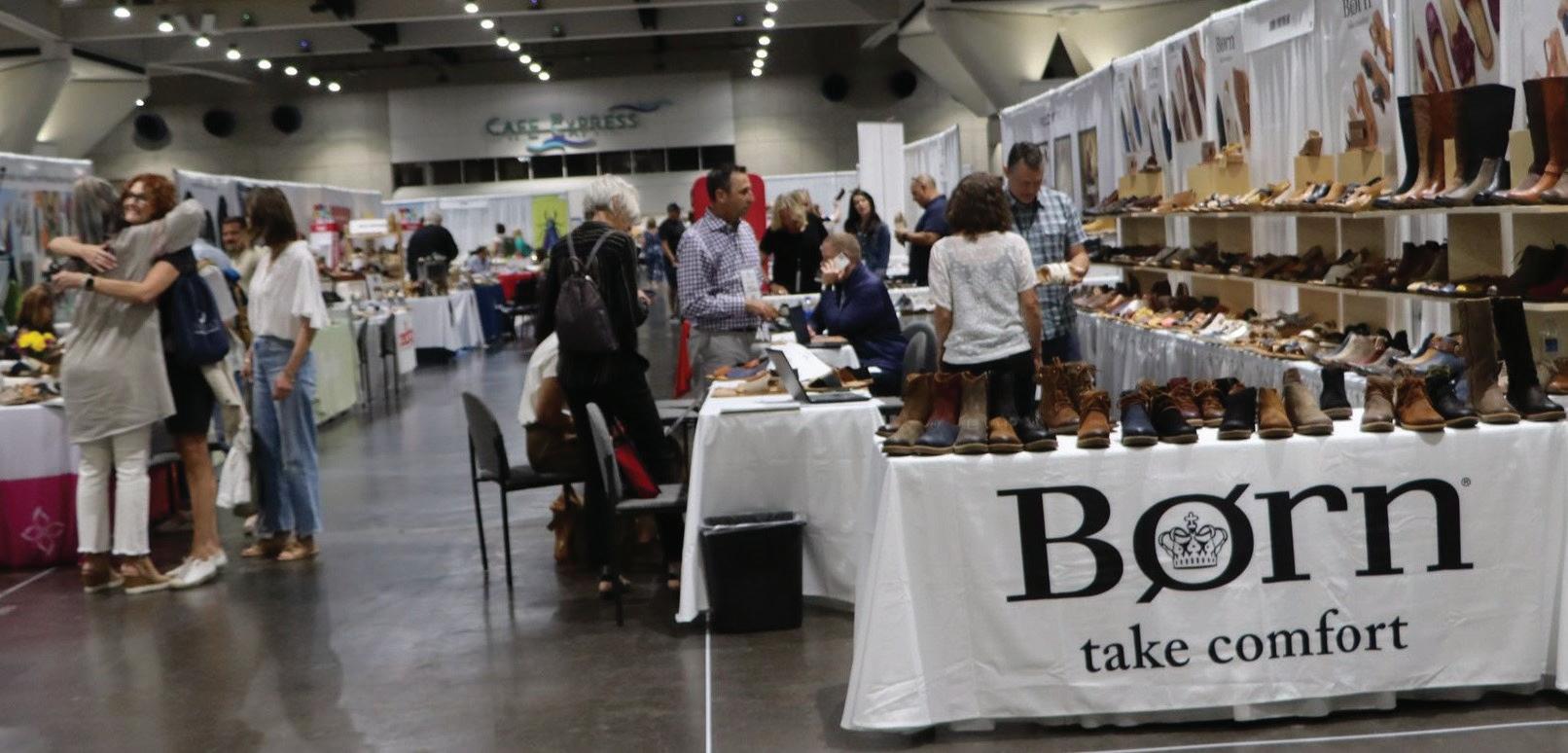




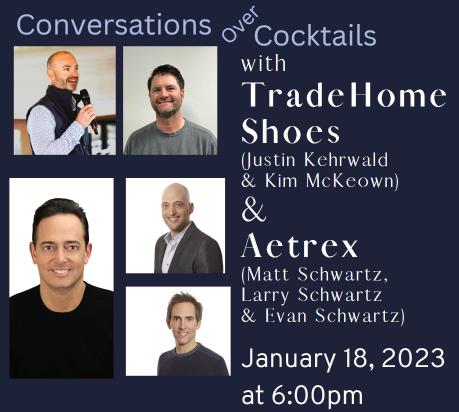
J A N U A R Y 1 7 - 1 9 , 2 0 2 3 R E G I S T E R T O D A Y ! W W W . T h e I R S h o w . c o m 2 8 0 1 5 S m y t h D r . V a l e n c i a , C A 9 1 3 5 5 S A N D I E G O C O N V E N T I O N C E N T E R M I X ' N ' M I N G L E C O C K T A I L P A R T Y Events at The IR Show January 17, 2023 6:00pm M O R N I N G S E M I N A R P R E S E N T E D B Y U S R A & O M N I W I T H T W O T E N January 18, 2023 7:45am Come see the BEST brands & retailers in the industry. Buy, Sell, Network & Connect at THE IR SHOW 2023 C S @ T h e I R S h o w . c o m
younger consumers, Berry says. Athletic brands have done amazingly well at demand creation, while the entire dress-casual segment has done poorly, in Berry’s opinion. “Telling our story better is our biggest challenge,” he says. “If we are successful and get them into the brand, we’ll absolutely retain them because our products last longer, are more comfortable and more sustainable. We really like our values proposition. We just need to get that story out to more consumers.”
To achieve that, Berry is focusing on retailers. Unlike DTC, which he says is like selling in a vacuum, retailers present the best conduit to reach existing and new customers. “When you engage with a broader distribution, you can present many facets of your brand,” he says, citing retailers who are youth-, comfort- and fashion-focused. “There’s no reason we can’t play in all those channels, delivering unique and tailored assortments, which gives us access to many more customers than if we try to force everything though our narrow DTC prism.” Berry also believes winning at wholesale represents next level success. In fact, when his team reports a strong sell-through on a style, he immediately asks whether it’s in the deep or shallow end of the pool? Meaning, is it wholesale or DTC? “We’re only competing against ourselves on DTC,” he says. “Whereas, if we achieve a great sell-through at wholesale, then I know we’ve delivered something really consumer-right.
“Wholesale sharpens your product focus,” Berry adds. “To win there, you’ve got to be the best against an array of competitors, whereas in DTC you can kid yourself with strong sell-throughs.”
Ecco’s new and refined (think a tighter assort ment overall) story will begin in earnest in Q2 of next year, when a new marketing campaign will launch, Berry says. In the meantime, the product assortment is already being curated, which entails a core and franchise approach. “Our assortment had been far too broad; we’ve been trying to be too many things to too many people,” he says, noting that this leads to brand dissolution and confusion. “We want to tell fewer, better stories.”
For a man who’s been helping craft great brand stories for nearly 25 years, Berry is well-suited to tell Ecco’s. But an impressive resume wasn’t the only factor that led to his joining the company a year ago. It was the gem-like qualities—the ones that shine with huge growth potential—that caught Berry’s eye. “We all want to be a part of something that we believe we can win with, but if you don’t have the right talent, you don’t have a chance to compete for a championship,” he says. “Ecco has the talent: family-owned, values-driven, great platform and exceptional product. The opportunity to turn this hidden gem into something much more for today’s modern family is super-compelling.”
How would you assess year one of leading Ecco Americas?
It’s been a very productive year overall. Our big gest challenge remains stabilizing operations. We need to become a top tier, reliable supplier that delivers on time and meets our wholesale customers’ needs. It’s our top urgency, and we are getting there. Meanwhile, brand has been our most important initiative. This past year, we set the pitch and we’ll unveil our new brand proposition early next year. We’re super happy with how that’s progressing. In regard to product, we’ve made major strides in culling our assort ment overall and creating consumer clarity this
year. Think fewer and better, which have included some great new winners. On that note, you can’t just be a consistent performer anymore; you also need must-have items that deliver excitement to consumers. Lastly, which is more internal but very important, has been pivoting our corporate culture from industrial, factory-led to consumer, brand-led. It’s a work in progress that certainly takes more than a year, but we’ve made major strides reorienting our entire enterprise to put consumers at the center of the conversation in every aspect. It’s the only way you can win in the long-term. Better factories aren’t enough to win today. Winning requires must-have product from
OFF THE CUFF
What are you reading? The Daily Stoic. In these crazy times it reminds you that you can’t control the world around you, but you can control your actions. For example, I couldn’t control the pandemic, but I could control my responses to it. It helps you be more productive, whereas a lot of people waste energy on things they can’t control. These philosophies were communicated 2,000 years ago and feel 100 percent relevant today, which is a thread of humanity that’s also comforting.
What was the last series you streamed? Patriot. It’s a wry mash-up of Wes Anderson meets James Bond meets Inspector Clouseau.
What might people be surprised to know about you? It’s been 35-plus years since I’ve lived in Cleveland, but I’m still a big hometown sports fan. I believe you’re always where you’re from, so those teams will be mine until I die.
What was the best business advice you’ve ever received? Back in my North Face era someone told me spoiled milk doesn’t unspoil. Meaning, old/ bad inventory never gets better. You’re way better off taking the loss and moving on.
Who is your most coveted dinner guest? My family. Any opportunity to have a meal with my three kids and wife is a dream. Even if I can get one kid, I’m happy. If you don’t prioritize those times, you can go through life like ships passing in the night.
What is your favorite word? Alchemy. Our business is this unique blend of art, science, luck and magic. Sometimes we forget that and over-index on one of those aspects. It’s about how it all comes together, even if there isn’t a perfect equation. That’s why it feels like alchemy.
What is your least favorite word? Lazy. Hard work doesn’t guarantee success, but laziness almost always guarantees failure.
What is inspiring you right now? The future. So often we focus on the challenges and not the progress. Look at our relatively small world of footwear: It’s amazing how much better shoes are overall than they were four decades ago. I’m intrigued and inspired by what the next four decades will bring.
What did you want to be when you grew up? A writer. That didn’t happen, but I believe that storytelling ambition put me on this consumer goods path. If you’re doing that well, you’re telling a great story.
What was your first paying job? I was 14 years old and a bag boy at Russos Stop-n-Shop.
What is your favorite hometown memory? Polish Boys, which are kielbasa, fries, sauerkraut and hot sauce mashed together on a bun.
What are five words to describe your life? I have two: family and team. I’m thankful to have the wonderful support of my family that’s been there for me through everything. And I’ve worked with some great teams over the years. If you’ve got a great family and team, you’re going to be in a much better situation. I don’t believe in individuals and stars; I believe in family and teams.
What is your motto? FIDO, which stands for forget it, drive on. I learned it as an Infantry Officer in the Army. We all get knocked down, but you’ve got to pick yourself up and keep moving forward. It’s a useful rule, whether it’s pandemic, business or personal challenges. It gives you purpose. Pity is the absence of purpose.
Q&A 12 footwearplusmagazine.com • december 2022

/Springfoot wear springfootwear.com | 800.962.0030 Style | BELGARD BE A FORM OF ART FW | 2023 COLLECTION NEW YORK NEW SHOWROOM 1370 Avenue of the Americas Suite #601B COME VISIT US AT OUR
a must-have brand, and to achieve that you must have the consumer at the center of everything you do.
What were some of this year’s must-have items?
Some were in our Heritage collection, like the Grainer, Staker and new itera tions of the Track. They’re classic silhouettes with no break-in period. So, out-of-the-box comfort that offers great support, cushioning and durability. With consumers having primarily worn sneakers for the last decade, it’s hard for many to go back to a traditional construction. That’s why we’re offering wonderful DriTan leathers to gain their attention. They use less water and fewer chemicals and are much better for the environment, plus have no break-in period and all-day comfort. We’ve also experienced success with our Street and Soft 7 franchises, which is primarily due to making sure those court silhouettes have the right last shapes as well as material and color iterations. That’s innovation with a small i for what continues to be a giant market. The fusion of dress, casual and athletic often lends itself to that silhouette, which can be dressed up or down.
How might Ecco’s golf category play into this culling down of styles overall?
It’s still a very important category. We’re the No. 1 brand above the $200 price point and our business continues to accelerate based largely on strength of product because, frankly, we haven’t done a lot of marketing in that segment. We also see golf as an entry point for reaching new consumers, especially younger ones who know Ecco only as a golf brand. They’ve already bought into our performance proposition, so why not have better product in the office and casually, as well?
How does outdoor fit into this overall approach?
We have a wonderful franchise in BIOM, which is all about natural motion. Lots of consumers know and love that product. Still, we need to introduce more consumers to it. But our focus going forward will be more on light hiking and everyday outdoor styles as we look to own the walking category, which is where we believe we’ve got the best technology and brand permis sion versus trying to be top of the mountain. We don’t want to be La Sportiva or Salomon. We want to be Ecco where the vast majority of people doing outdoor activities lends itself to our designs. There just aren’t that many people at the top of the mountain or trail running. But there are a ton of people light hiking and walking, and they need the durability, comfort and support our shoes offer.
How does this year’s launch of Gruuv fit into all this?
Gruuv is our new walking technology. The fact that we make all our own molds and do our own engineering and creative gives us enormous technology advantages, and Gruuv is an example of that. It’s a further iteration in natural motion and support that delivers great comfort. We believe a lot of brands
have over-indexed on cushioning, which is a solution optimized for the heavy forces associated with running. Meanwhile, brands have under-indexed on support. In terms of kinesiology when standing and walking all day, durability and support are more important than cushioning. Yet consumers have been so sold on the need for cushioning. They haven’t been educated enough on the benefits of support and durability. Our construction is also closer to the ground, so you don’t feel tippy. We find that a ton of consumers, especially older ones, prefer that sensation. While there are times you need more cushioning, the vast majority of the time you need durability and support. It presents a massive advantage for Ecco.
Might athleisure fashion in general be nearing a cliché status?

I think so. I believe there’s a moment coming soon when a lot of it will look absurd—like ’90s-era stirrup pants and fluorescent colors. People are going to look at some of things that we’ve been wearing over the last decade and say, ‘Wow, what were we thinking!’ That’s not to say it’s all bad. Take the classic court sneaker silhouette, which is our flagship Soft 7 collection. That’s ‘athletic’ for us, and that look remains just as relevant today. We own the classic court silhouette dressed up in better leathers with a more durable construction at a higher price point. That’s who Ecco should be. We don’t need to chase the far reaches of athletic/athleisure street fusion because that’s not who we are authentically.
Could this casual lifestyle segment be the biggest category of all?
From a wearing occasion perspec tive, yes. The casual segment is under-maximized, yet it has by far the largest market potential. The irony is athletic brands have been winning with athletic silhouettes for casual-wearing occasions. We’ve let those brands take over a lot of the casual-wearing moments. For example, my family recently hosted a homecoming party and most of the kids showed up in suits and dresses paired with sneakers. It’s not surprising though, as the only brands that have really communicated to them in their years of growing up have been athletic ones. Ecco, in contrast, hasn’t spoken directly to an 18-year-old in the last 30 years. That’s an opportunity, right?
Because?
We believe a lot of consumers want the style point of view of dress-casual, but with athletic comfort. So, rather than trying to look like athletic brands, which we had been doing too much of, we need to tell our story about our longer-lasting, all-day comfort, and why it’s a better proposition for the vast majority of consumers. So, you’ll see many more classic silhouettes with incredible comfort, sustainability and durability built into them. I think we’ll win by being that brand versus trying to chase athletic brands. Now, I’m not suggesting we’re going to become a “teen” brand any time soon, but look at how well Birkenstock has done reaching that audience of late.
14 footwearplusmagazine.com • december 2022 Q&A
Ecco’s new Gruuv walking collection is engineered to deliver support, durability and all-day comfort.
They’re an ageless brand that’s done a great job at brand building on product that hasn’t seen a profound evolution in the assortment. It helps show us the way. That’s why we’re targeting the modern family. We believe we’re in a world that’s post defining brands by ages. If you can define a brand by values and unique product propositions, you can capture a lot more consumers, because values today tend to be much more transcendent than when we were young. Kids are a lot more socially conscious today. Sustainability and durability matter to everybody. So does quality and comfort.
On that note, what is the potential for Ecco in the years ahead?
We are already a leader in the dress and casual space, but that space is currently too small. So, we want to grow the entire space, as well as take market share within it. That all revolves around owning those casual-wearing occasions. We believe we’re uniquely positioned to deliver and communicate on the needs for comfort, quality, durability and sustainability from a values-driven company. That involves reaching a cohort of new and younger consumers while continuing to deliver great solutions for our current ones. There’s no reason we can’t reach both. That aside, it’s a long runway and we don’t presume it’ll be an easy journey. It’s a very competitive and dynamic marketplace. At the same time, we don’t see any strategic obstacles to getting there. It’s more an execution play. If we execute, we expect to win.
It’s one thing taking market share from a relatively small brown shoe brand, but isn’t it a whole different level to do so from Nike or Adidas?
Oddly enough, it may be easier. We don’t need to be better than Nike at running or basketball, we just need to convince consumers who are going to the farmer’s market, for coffee or to watch their kids’ ballgames—activities the modern family is doing—that you don’t have to wear athletic shoes for those casual-wearing occasions. Previously, we thought the path to winning was to be more athletic and compete with those brands on their pitch. That’s completely wrong. Athletic brands are on our pitch. We just need to educate con sumers that we’re the better, more sustainable solution for casual occasions. So, we don’t need to take massive share from Nike. If we just take share around the edges of those brands, it would amount to massive growth potential financially and market share–wise.

How important is sustainability to Ecco’s overall pitch?
Very. Consumers increasingly want products that aren’t fast fashion, which is stuff they throw into landfills after a season or two. They’re reacting negatively to all the fluff that’s been contaminating the shopping universe the past decade or so. The food industry is another example. It had gotten so dumb-downed with cheap and unhealthy options to the point where consumers demanded healthier ingredients from brands that share their values. I think you’re going to see similar trends in footwear and apparel. Consumers want authentic goods that can be kept in their closet for 10 years, which favors Ecco. So, we’re absolutely pursuing what I call a slow style business model. For example, sales of some of our best styles–like the Track and Soft 7, which have been in our line for 27 and seven years, respectively—have never been stronger. Our Yucatan sport sandal has been around for 16 years, and its sales have been the strongest ever this year. I think brands, in general, should be pushing timeless design and durability, which are probably the two most important yet under-told sustainability stories. Too many products that aren’t worn out but quickly become out of style wind up in landfills. Similarly, a lot of products perform well for three to six months, but then the cushioning is gone and you’ve got to buy a new pair. In contrast, we build most everything on a PU platform featuring our direct-injection FluidForm construction, as opposed to the more common cement and EVA method, which results in more pollution and less durability. We’re working on a study now that shows our approach is four to six times longer lasting. If you can put that many fewer shoes into landfills, that’s a massive unlock. Plus, consumers will save a bunch of money, because even if ours are premium priced, if they last five times longer, people will come out ahead in the long run.
A good pair of shoes provides a legitimate value and purpose unlike, perhaps, crypto. How can there really be a $19 shoe? Something is wrong with that whole concept. That shoe is going to be a social proposition that a growing number of consumers don’t want to be a part of, because it’s not going to last, it won’t be comfortable and it’s likely bad for the environ ment. There’s really no such thing as a $19 shoe that’s good. Consumers are learning that if you want better quality and values, you’re going to have to pay more. But I believe they’ll do so happily, because, as you just noted, there are a lot of things competing for their money >39
Q&A
CHUKKA CAN!
I FIRST DONNED Clarks’ iconic Desert Boots in grade school, back in the groovy ’70s. It was the day of my 6th grade graduation, to be precise. My parents—and pretty much every other parent of boys—had decided that sneakers wouldn’t cut it for such a momentous occasion. So, there we all stood, lined up in rows on the stage inside a sweltering, packed Tuscan School audi torium sporting a uniform of sand-colored Clarks Desert Boots paired with either tan or blue three-piece polyester suits. I swear, it looked like a pint-sized Saturday Night Fever fan convention. The disco duds were constricting, but the boots were lightweight, breathable and very comfortable. Those crepe soles were stealth! In truth, the Clarks Desert Boots were the closest thing to wearing sneakers, yet we all looked “dressed up.” My classmates and I made a collective step toward growing up that memorable day, and the Desert Boot (and Clarks’ Wallabee) would remain a go-to dress-casual style throughout
our remaining school years and beyond.
Of course, this is just one historical anecdote about the iconic Clarks Desert Boot. Over the 70-plus years of its existence, the boot has attained forevercool status, becoming a closet staple in both men’s and women’s wardrobes. Along the way, trendsetters like Steve McQueen, Bob Dylan, Liam Gallagher, Anthony Bourdain (who was quoted in Men’s Journal describing them as the “most comfortable shoes on Earth”) and Sarah Jessica Parker have sported the style. Even Manolo Blahnik is reportedly a fan. Macro speaking, the Clarks Desert Boot has been adopted by Mods, Beatniks, Rude Boys and Hip Hoppers over the years. Estimates, made back in 2011, put sales north of 10 million pairs, sold in more than 100 countries. What’s more, London’s Design Museum, in 2009, named it one of the “Fifty Shoes that Changed the World.” Not surprisingly, the silhouette has been co-opted by legions of other brands,

16 footwearplusmagazine.com • december 2022
Amid the vast barren landscape of indiscriminate designs there lies an oasis of eternal cool, casual fashion that is the Clarks Desert Boot.
By Greg Dutter
turning the style into a reliable, year-round category all its own, similar to Birkenstock’s Arizona sandal.
Lester Wasserman, owner of Tip Top Shoes and the sneaker boutique West NYC in Manhattan, says the family-owned business has been selling Clarks Desert Boots since the ’70s—back when the shoes were made in England. He says customers appreciate the authenticity, heritage and simplicity of the design. “Sand or beeswax, you can’t go wrong,” Wasserman says of the peren nial seller. “Over the years, there have been highs and lows, but it’s always around and it’s always a cool, iconic style.” Wasserman says that’s what fuels the strong crossover gender appeal. “Classics lend themselves to that kind of interest—everyone wants to own a classic,” he says.
A 1,000 YEARS STRONG
The genesis of Desert Boot actually came much earlier than its official debut in 1950. How about a 1,000 years! The Khoisan tribe, foragers in the Kalahari Desert region, are credited with the original unstructured suede upper/crepe sole concept. The design was ideal for traversing sandy, arid, hot terrain. Later on, in the 17th century, Dutch settlers came upon the boots (then called Veldschoen). They became a work boot fave of South African boar farmers.
But it wasn’t until 1942 that the seeds of the Clarks classic were planted. That’s when Nathan Clark—great-grandson of James Clark, founder of C&J Clark, a.k.a. Clarks shoe company—first came across the boots while serving as a member of the British Army’s West African Brigade. As shoe lore goes, Clark had been instructed by his older brother, Bancroft, the newly appointed Clarks CEO, to keep an eye out for unique shoe designs. He came upon the style at a made-to-order stall in a bazaar in Cairo. Apparently, 8th Army officers also saw the advantages of the boot’s lightweight, breathable, flexible and unstructured construction, which were ideal for fighting in the Sahara as opposed to the heavy, stiff and hot military boots of the time.



Clark sent sketches and rough patterns to his brother, but it wasn’t until the war ended and he had returned to England that the first Desert Boot samples were crafted in 1946. The team’s initial reac tion, however, was ugh! “They’d never sell” was the consensus. Rather than ditch the design, though, Clark took it with him when he launched Clarks Australia in 1948 and soon after began selling Desert Boots there. The style then caught on in the West Indies. (The Desert Boot has since become entwined with Jamaican music and culture.)
In 1949, Clark attended the Chicago Shoe Fair where he met Esquire fashion editor Oskar Schoefler. The magazine was the authority on men’s popular fashion at the time. Schoefler saw the boot’s potential international appeal and, more importantly, a void the style could fill in a burgeoning casual fash ion landscape. He wrote an article in Apparel Arts in 1950 on the merits of the Clarks Desert Boot that caught the attention of Bronson Davis, a veteran
2022 december • footwearplusmagazine.com 17
Likes sands through the hourglass, so are these iconic ads of the Clarks Desert Boot.
salesman who would soon become a Clarks rep in the U.S. and played a major role in the Desert Boot’s early success.
UTILITARIAN CHIC
Like a handful of iconic shoe designs (think Converse Chuck Taylor for basketball, Dr. Martens’ 1460 work boot and Teva Universal sport sandal for river rafting), the Clarks Desert Boot’s design roots are utilitarian. But shoes built with a specific use in mind often work well for a myriad of other occasions. A rare few are so versatile and loved that they become a part of mainstream fashion. The Ugg boot is an example. First worn by Australian sheepskin farmers in the early ’20s—because its materials were resistant to wool yolk, which commonly rotted other boots—they were adopted by surfers in the ’60s as a way to stay warm after leaving the water. The boots are cozy, comfortable and versatile. The rest, you might say, is utilitarian mainstream fashion history.
The Clarks Desert Boot followed a similar trajectory, albeit over a longer stretch of time. It, too, is versatile, comfortable and, if you happen to be crossing the Sahara, a great, lightweight and breathable option. Like the aforementioned iconic styles, though, it is among the few with enduring appeal and long-running success. Who would have expected a nondescript chukka designed to traverse barren landscapes to become a perennial poster child of hip, casual fashion? You might say the possibilities were as remote as the Kalahari Desert that helped spawn the Clarks Desert Boot.
“The beauty in the design makes it a timeless closet staple,” says Tara McRae, chief marketing officer of Clarks. “The Clarks Desert Boot is as versatile as it is comfortable. The simplicity of the construction naturally lends itself to upgrades in material and color, which brings a seasonal twist to our icon year after year. In addition, so many different sub-cultures and influential communities around the world have fallen in love with the style and continue to drive its fame.”
McRae says the Desert Boot is for everyone, describing it as a perfect intersection between functionable and fashionable. “With just two upper pieces and a sole, it’s the very definition of sophisticated simplicity,” she says. “This minimal, progressive construction lends itself to limitless styling possibilities, and it can be dressed up or down—the ultimate casual shoe. Our wide range
of material and color options add to the boot’s versatility.”
Nick English, founder of Stridewise.com, a blog devoted to men’s footwear, describes the Clarks Desert Boot as a “gateway shoe” to adulthood. English, who grew up wearing standard-issue Clarks uniform shoes while attending school in Australia, confesses to taking a rebellious break from the brand in his later teen years and early twenties. That was until he realized that the Chucks he had been sporting sent a sartorial message that he no longer wanted to project. “Once you get a little older, you want to wear something that has a little more quality, lasts a little longer and is generally more respected for an adult to wear,” he offers. “That’s where the Clarks Desert Boot—or,
KEEP ON CHUKKING
The Desert Boot’s origins date back a millen nium, so it’s safe to assume it’ll stick around for the foreseeable future. McRae says the Desert Boot’s blank canvas–like upper helps keep it going. “Throughout the years, it’s been reimagined in countless material and color combinations,” she says, noting popular materials have included beeswax and nubuck leathers as well as hairy suede, while consistent colors have ranged from traditional black, brown and navy to seasonally relevant hues and prints. Then there are the numerous collabs with equally iconic brands and designers that also help keep the Desert Boot relevant and fresh. Notable examples have included Drake’s OVO, Todd Snyder, Levi’s, Beams, National Geographic and Bape. “We look forward to continuing to develop fresh adaptations with prominent designers and artists in the coming seasons,” she says, adding that fans can expect to see a handful of projects in 2023 and beyond. “It’s one of our most precious icons, so we always have something exciting cooking with it,” McRae says. “Stay tuned.”
as Reddit refers to it, CDB—comes in as a casual entry shoe for young adults.”
English cites the Desert Boot’s overall versatility as a key to its long-running success. “The flexibility, lightness and shock absorption of that crepe sole are a big part of the appeal,” he says. “Combine that with the unstructured, full-grain suede upper with only a couple of eyelets—it just comes together as a shoe that doesn’t grip the foot as aggressively as a lot of other shoes out there, even the average sneaker. It’s so light you can barely feel it on your feet.”
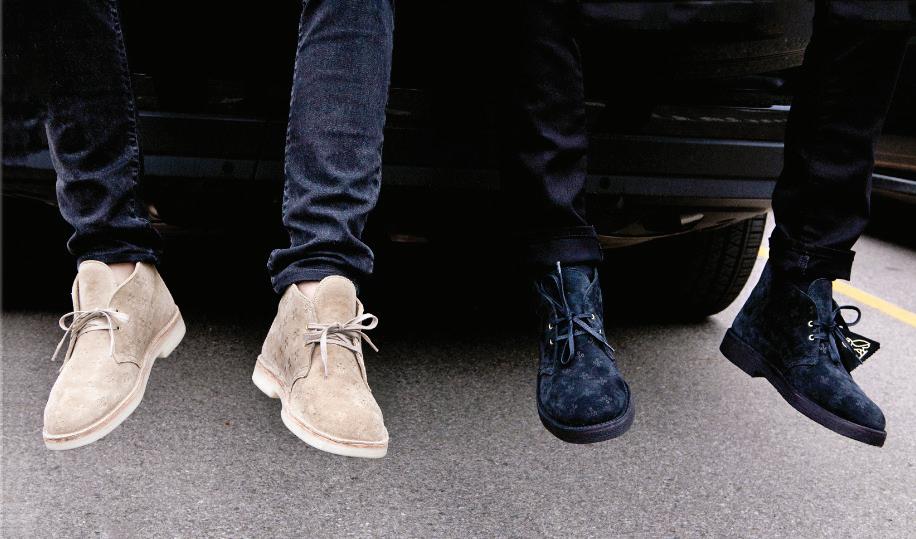
Stylistically, English describes the Clarks Desert Boot as that elusive sweet spot of sophistication without trying too hard. And that is his guiding fashion principle. “If I look at a photo of myself in 20 years, I’d like to not be embarrassed by what I was wearing,” he says. “The Clarks Desert Boot paired with knockout washed jeans, an oxford button down and a waxed leather trucker jacket is an example of timeless fashion that also doesn’t look like you just shopped the local vintage store.” English adds, “There’s a fine balance, and the Clarks Desert Boot fits very neatly into that timeless classic aesthetic.”
As far as English is con cerned, the original sand suede upper is the Clarks Desert Boot at its most iconic and finest. “It’s got to be suede,” he says, adding that full-grain leather chukkas just don’t sit right with him. “The Desert Boot fits neatly in that space where it’s casual, but not too casual, and dressy, but not too dressy. And the lighter suede just works better in that realm. It’s polished, but you can still wear it with a t-shirt and jeans.”
That’s not to underestimate the allure of the crepe sole. McRae says the material, which is made of all-natural and biodegradable tree sap latex, provides “ultimate underfoot comfort.” It’s more cushioning, she adds, than traditional rubber soles. The unique texture also provides added traction and is significantly lighter than many other sole materials. “Our crepe soles are also visually arresting, standing out from typical darker, lugged boot soles,” McRae adds.
English is in lockstep on the Desert Boots’ crepe soles as a key element of its design. “A lot of guys never grow out of sneakers, but the Desert Boot is quite sneaker-like for a boot,” he says. “It’s a very accessible piece of footwear. Call it a gateway shoe to structured leather footwear, in general.”
Conclusion? “They’ll always be in style,” Wasserman predicts. •
18 footwearplusmagazine.com • december 2022
Drake approved: OVO x Clarks Desert Boot from 2017.

FIT TO SPRINT
From sprinter to software engineer to stand-up comedian, Xero Shoes Cofounder Steven Sashen’s resume runs here, there and everywhere.


HEY, 21-YEAR-OLD SASHEN, it’s me/you from 39 years in the future! You’ve seen enough movies to know I’m supposed to prove this by saying something only you can know, but I don’t have time. I also know that if you do anything different after reading this it screws with space-time continuum and eliminates any chance of you dating a Charlie’s Angel or winning Battle of the Network Stars. But it also might help clear up that rash. So, in no particular order, here’s a little heads up on the years ahead.
You Don’t Do “Career”: Give up the idea that you’ll find something that you’ll want to do for the rest of your life. If you were born a few years later and prescribed Ritalin, perhaps you’d have been career focused. Instead, professions will catch your fancy, sending you down numerous, interesting roads. Where, you ask? How about stand-up comedy. (Yes, for a living!) Other roads taken: Developing Scriptware, the industry-standard software for film and TV writ ers; hosting Disk Doctors, a syndicated TV show that makes you famous in Bermuda; internet marketing; and teaching meditation.
As for your best-laid plans to retire by age 35, that won’t happen until you’re 38, thanks to some clever real estate investing. But retirement is short-lived due, in part, to keeping in your All-American gymnast shape. That’s what leads you back into sprinting, at 45. Lots of injuries follow, which leads you to discover the life-changing benefits of barefoot running, making you a Masters All-American sprinter, one of the fastest 60-plus people in the country! During this stretch, on Nov. 23, 2009, to be exact, you cofound Feel the World, makers of minimalist Xero Shoes, with your super-smart and beautiful wife. (More on her in a bit.)
Do Your Best, Prepare for the Worst: As an individual sport athlete, you believe the best man wins. Same for business: the best idea/invention/product wins. Well, you’re wrong. That doesn’t mean trying your best, or making the best products possible. It means be prepared for dirty play in the win-at-all-costs shoe biz. When you threaten someone’s livelihood, their first move often is to shut you down by doing something underhanded. For example, in Xero Shoes’ salad days you’ll get a huge order from a major retailer and think you’ve made it. But then that retailer receives a call from a company 2,000 times your size saying, “We don’t want Xero Shoes in your store.” The order gets killed. But keep changing people’s lives by believing in your product. A couple years later, that retailer will add Xero Shoes to its mix and you’ll crush it.
You’re Only Human: Ninety-nine percent of what you think is wrong with you is what every human thinks about themselves. Trying to fix those imagined flaws with the hopes it’ll lead to happiness will only make you unhappier. Understanding this will save you a ton of cash and frustration when some guru tries to sell you a foolproof method to build a successful company. You’re in unchartered territory. Learn to build your own map.
Work Hard: I know you prefer the fastest, easiest way to do everything. But the ultimate payoff you envision for Xero Shoes will require a lot of hard work. While being successful is 90 percent luck and 10 percent also luck, there’s a separate 100 percent where 90 percent is working your butt off and 10 percent is, hopefully, being smart enough to put out the fires that start overnight despite nothing having changed from the day before. That’s just business. It took you three years of really hard work to become an All-American gymnast, and it’ll take you much longer to build a shoe company that changes the lives of millions of people by let ting their feet do what’s natural: bend, flex, move and feel.
Facts Don’t Always Matter: By the time you launch Xero Shoes, people will have had 50 years of being told their feet aren’t up to the tasks of walking, running, hiking, etc. unless they have a bunch of padding, motion control, arch support, elevated heels and toe boxes that squeeze their little piggies together. Still, people won’t try Xero Shoes just by hearing that research shows arch support makes feet weaker—like immobilizing any joint does. Or that padding doesn’t reduce impact forces. So highlight simple concepts—like stronger is better than weaker, and letting feet move naturally makes them stronger.
Wearing is Believing: The secret to Xero Shoes’ success: Get shoes on people’s feet! The rest takes care of itself. You’ll become “airport famous.” People will recognize you (the curly locks help), telling you how Xero Shoes changed their lives, they own multiple pairs, they’ll never wear another brand, they saw you on Shark Tank
TV is Good: Some self-unhelp gurus advise that, to be successful, you must eliminate distractions. But working 12-plus hour days, six days a week, requires breaks. So, get a really good TV. In the future, you can get one the size of your dorm room wall that costs half as much as that 14-incher you’ve got now! Get a great couch, too. You and your wife will curl up on it at night watching your favorite shows, like Breaking Bad. Now about that wonderful wife: I won’t tell you her name because you’ll pursue her even harder, and it’ll take even longer than the six years between first meeting to marrying the love of your life and who you wouldn’t be able to build Xero Shoes without.
Top Dog: You think dogs are too much work, but when you hear about a mutt named Paolo, get him. He’ll join you guys on the couch each night. You’ll love this dog. You may even think you love him more than your wife. That’s ok, though, because she’ll think the same.
Gotta run—literally. Good luck and enjoy the ride!
Steven
20 footwearplusmagazine.com • december 2022
A NOTE TO MY YOUNGER SELF
Twisted X Teams with Yellowstone Star
TWISTED X HAS gone to Dutton, currently the most famous ranch in all the land and the main setting of mega-hit series Yellowstone . That’s where the Decatur, TX-based western and work company has teamed with actor Jefferson White, a.k.a. Jimmy Hurdstrom, the former criminal redeemed as a cowboy, to endorse its Tech X boots collection featuring CellStretch comfort technology.
It’s all about the need to be comfortable in situations that can be far from it, according to White. “Comfort is huge for me at work,” the actor revealed in an interview with Twisted X before the recent debut of season five. “It really helps me settle into a character, which I always try to do early in production—to get into the character’s shoes, literally.”
Tricia Mahoney, chief marketing officer for Twisted X, says that in addition to the star power, White’s character brings genuine ranch cred to the brand. “Working on a ranch and living the life of a ranch hand is core to our Western audience, and Jefferson has gotten to experience

the demand of that role as he prepared for his Yellowstone character,” she says. “Comfort is a universal need that everyone can relate to, no matter who you are, and having comfortable boots is mandatory. In fact, in his interview with us Jefferson completely nailed it: ‘You have to be comfortable, period.’”



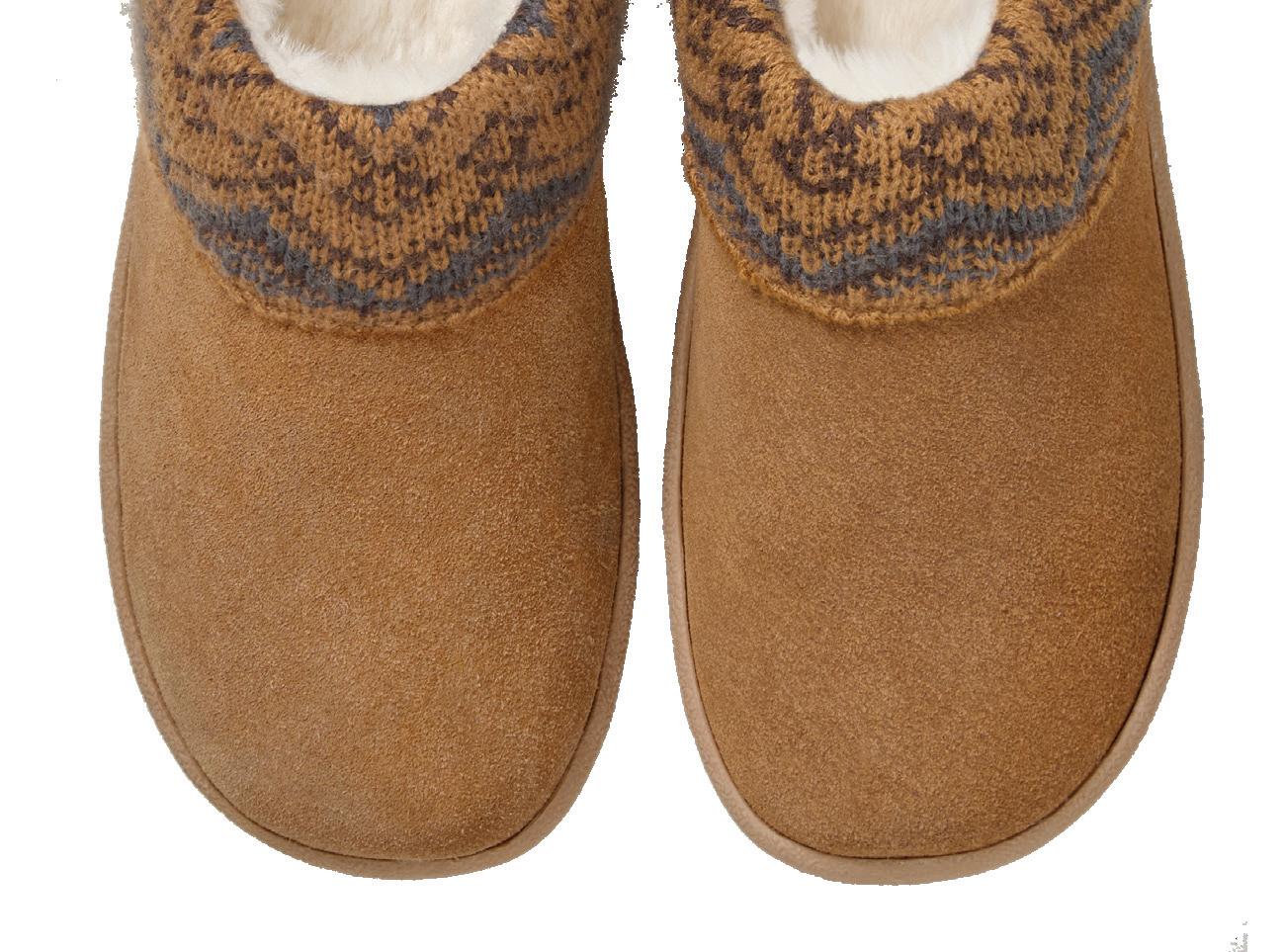
Tech X’s patent-pending CellStretch technology is housed within an EVA midsole that compresses, stretches, rebounds and distributes weight evenly. By activating more than 100 individual pressure points of comfort, each step gives the ball and heel customized and unparalleled support.
“Having boots that are comfortable to walk and ride in is so important.” White says. “And Tech X is comfort for cowboys.”
Mahoney says the partnership will include promotional assets in support of its retail partners. “We’ve provided free access to point-of-purchase materials featuring Jefferson, including posters, floor and window clings, and more,” she says. “We look forward to continued exploration of partnership opportunities.”

SCENE & HEARD
YOUR PARTNER. YOUR STYLE. YOUR BRAND. www.greenmarketservices.com Delivering exceptional value in private label and licensed slippers and footwear for over 50 years. © 2022 Green Market Services Co., Inc.
Jefferson White in Tech X boots.
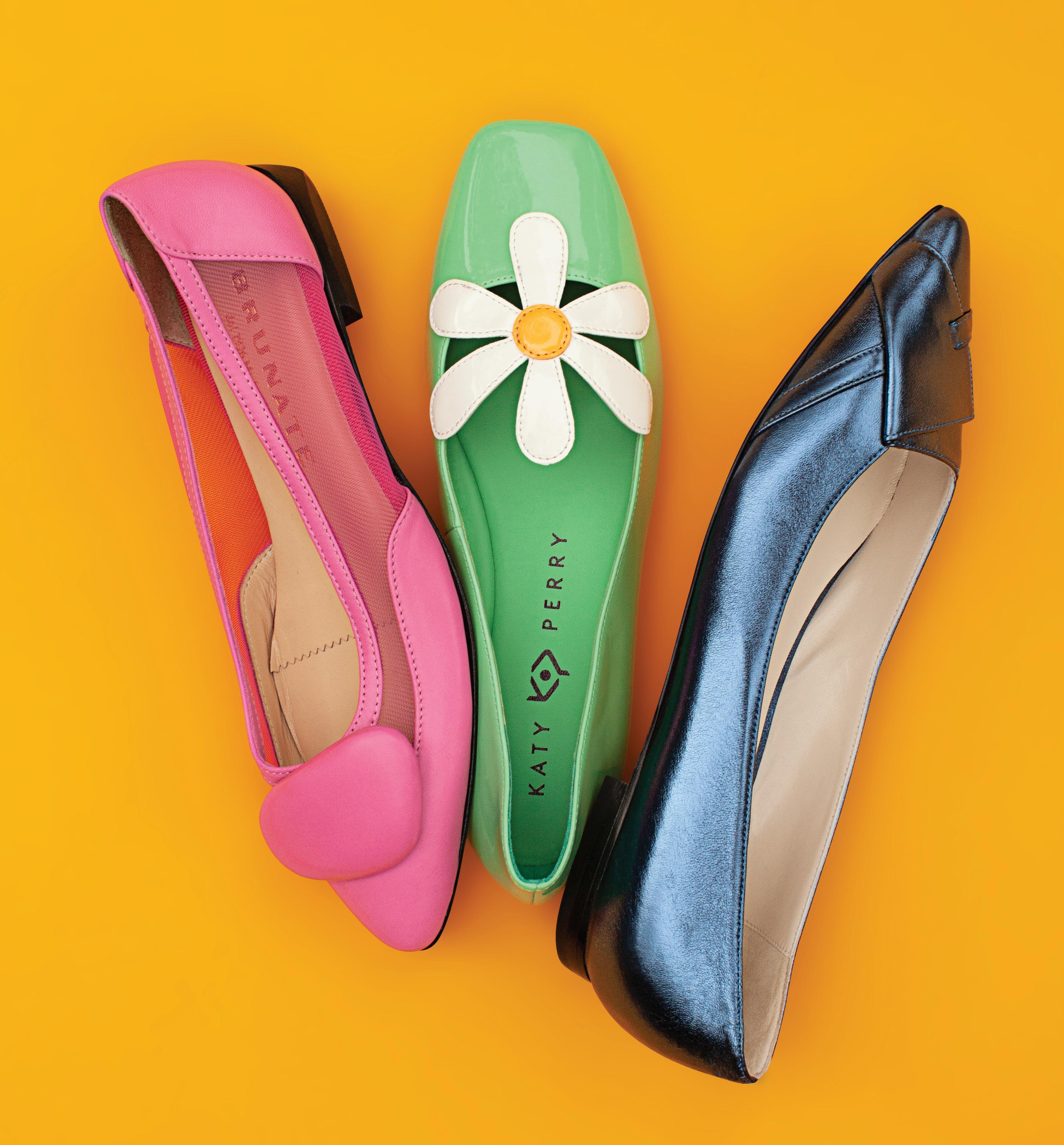
22 footwearplusmagazine.com • december 2022 TREND SPOTTING
FLATS FAVOR THE BOLD 1. Brunate 2. Katy Perry 3. Chris Donovan 3 2 1 Bright hues and eye-catching details refresh the classic silhouette.
PHOTOGRAPHY BY TREVETT MCCANDLISS

2022 december • footwearplusmagazine.com 23 TREND SPOTTING PHOTOGRAPHY
GET BACK! 1. Seychelles 2. Azura 3. Beautiisoles 4. Ron White 5. Enjoiya 3 4 2 1 Office-appropriate slingbacks transition seamlessly to after work activities. 5
BY TREVETT MCCANDLISS

24 footwearplusmagazine.com • july 2022
Ducanero
Geox
Vagabond
 Ron White
Taft
Wrangler
Spring Step
Ron White
Taft
Wrangler
Spring Step
25
Twisted X

26
Bos & Co. wood sole platforms.

 Seychelles chunky platforms.
Opposite: blush leather sandal by Patrizia
Seychelles chunky platforms.
Opposite: blush leather sandal by Patrizia
O2
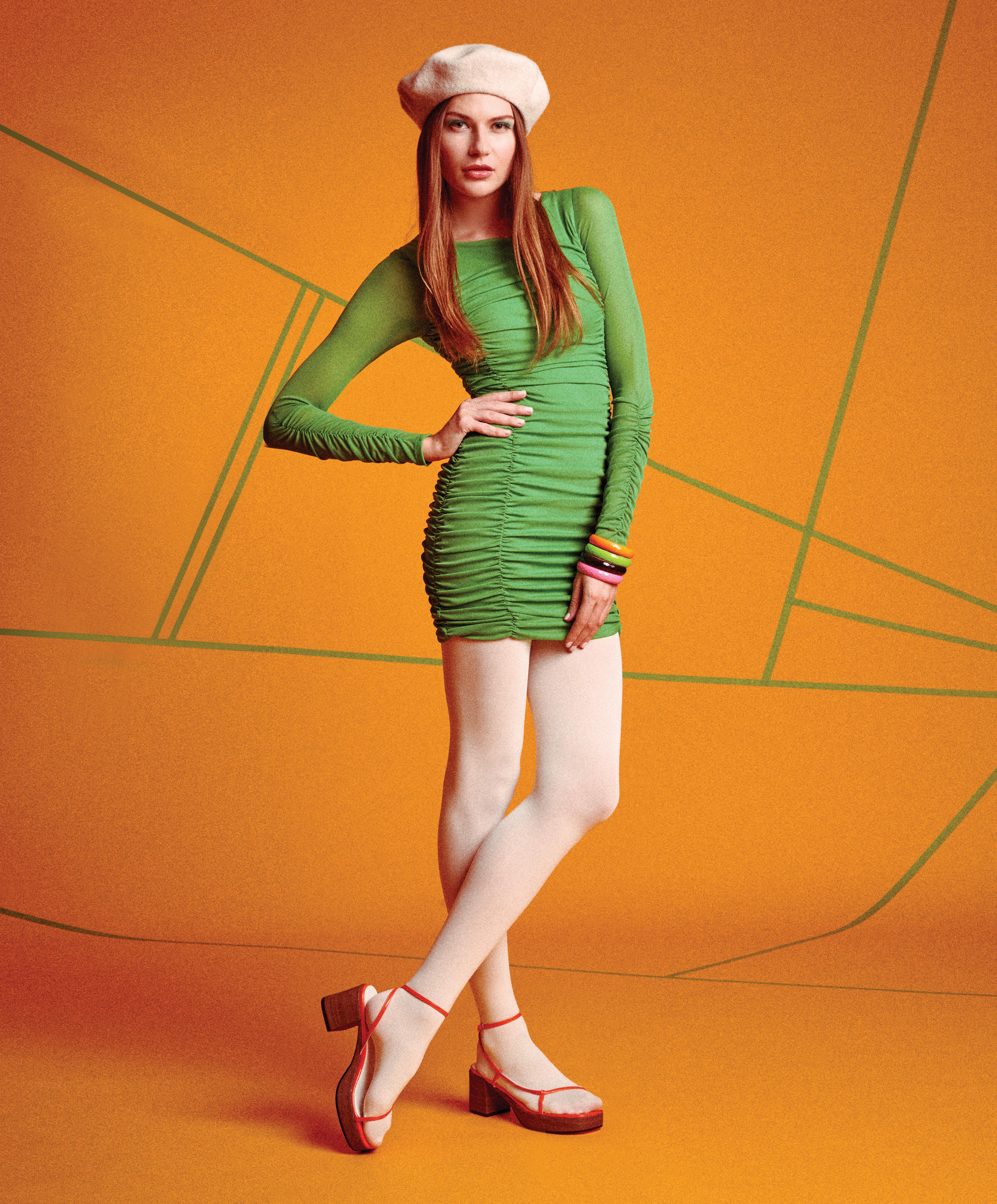 Monde strappy minimal platform sandals. Opposite: metallic leather flatforms by Beautiisoles.
Monde strappy minimal platform sandals. Opposite: metallic leather flatforms by Beautiisoles.
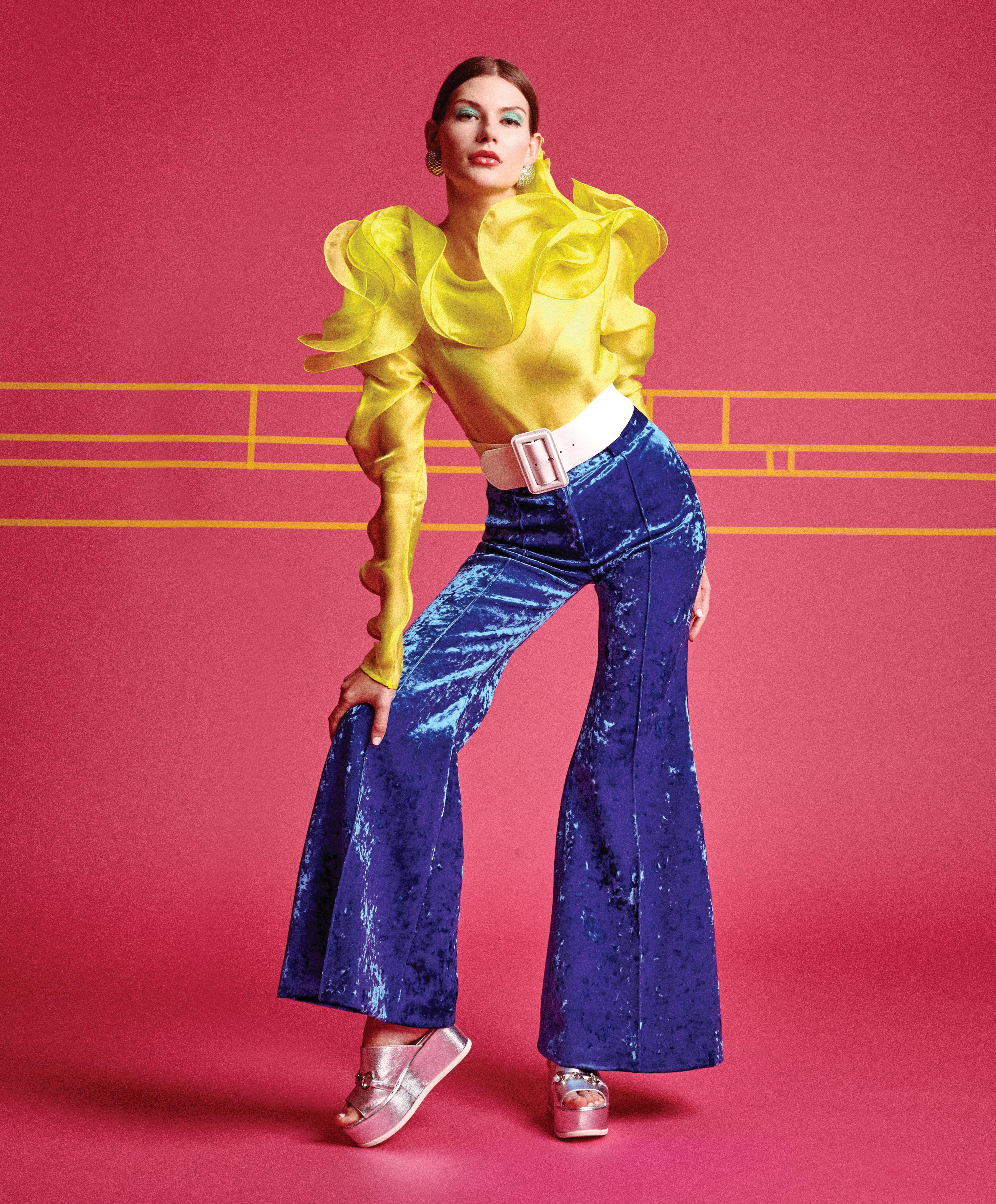
 Peep toe platform sandal by Chinese Laundry Opposite: Aerosoles all-over blush suede block heel sandals.
Peep toe platform sandal by Chinese Laundry Opposite: Aerosoles all-over blush suede block heel sandals.


 Yvonne Koné lightweight wood clogs with stud details. Opposite: metallic gladiator flatform by Katy Perry
Yvonne Koné lightweight wood clogs with stud details. Opposite: metallic gladiator flatform by Katy Perry

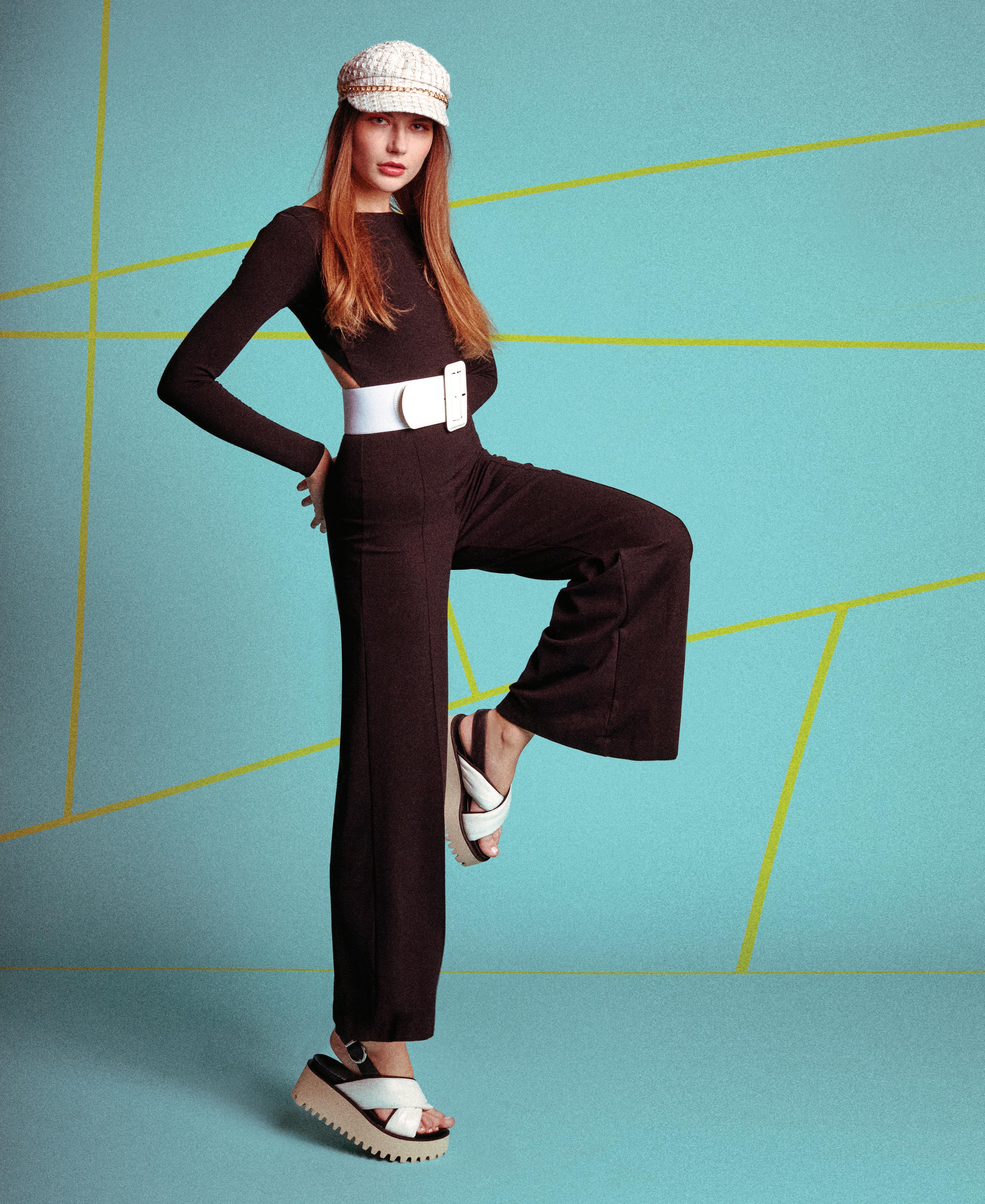
Moma block heel suede platform slides. Opposite: sawtoothed EVA flatforms by All Black
Photography by Trevett McCandlliss; styling by Nancy Campbell; fashion editor: Kathleen O’Reilly; model: Migle/Q Model Mgmt.; digital tech: Marco Scozzaro; first assistant: William Eadon; photo assistant: Raymond Collette; makeup: Maya Ling Feero; hair: Vera Koumbiadis; styling/production assistant: Sarah Frey.

A Vow to Wow
Former bridal designer says I do to shoes with launch of She is Cheval.
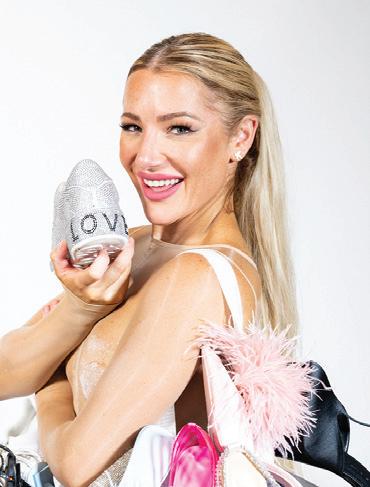

HALEY PAIGE GUTMAN, former designer for Haley Paige Bridal and of Say Yes to the Dress fame, had to leave her former business self (name included) behind following a breakup. But rather than wait for her non-compete to end in 2027, the newly self-named Cheval decided to step into the shoe business. And while footwear presents unique challenges, the designer has approached her new endeavor with the same drive that brought her notoriety in the bridal industry, which included celebrity clients and a top 10 ranking in 2017 by Vogue
But why shoes? Cheval cites a few reasons. “First, I feel a real connection to the development process from illustration and pattern making to embellishment and molds. I feel a familiar spark that excited me about what I could offer this new industry aesthetically,” she explains. “I also chose shoes because the product manifests a ‘walk it like you talk it’ mindset—a reminder to go your own way, own your story, go at your own pace and manifest your own destiny. It’s a fashion category that takes charge and takes you places.”
That philosophy translates to an overall aesthetic that Cheval describes as imaginative, sentimental and spunky. “The inspiration comes from holding onto who you are, especially when life gets complicated and gritty,” she says. “From childhood treasures and unwavering friendships to familiar pop-culture refer ences and song lyrics that transport you to a happy place, there’s a lot of hidden messaging, which I look forward to unveiling in small, special doses.” Cheval says to be on the lookout for flying unicorns, Morse codes made to empower, intergalactic references and maybe a locket for the tiniest of love notes. “I want this collection to feel like an exciting treasure hunt that puts a little pep in your step, reminds you to walk—or fly—your own path and encourages you to leave an optimistic trail for someone else to be inspired,” she says.
Such a grandiose vision translates to a debut col lection that is “quite varied and intentionally eclectic.” Styles span sneakers to slippers to sky-high stilettos to kitten heels—all connected with the designer’s generous thread of sparkle. “I love sentimental design, and I want this col lection to feel inclusive and otherworldly, which is why you will find ‘Made in this Galaxy’ printed on the soles,” Cheval says, adding that she has grand plans for the label going forward. “I see venturing into specialized projects and collaborations, i.e. military/veterans, disability community, athletes and even astronauts. As much as I gravitate toward sparkle, I love that shoes are needed just about everywhere. Plus, I can finally utilize more of my fiber science degree.”
How might your bridal experience be an asset in designing shoes? Staying authentic in my creative expression has always been important. With so much product out there and a lot of stimuli pulling you in different directions, it’s easy to get distracted, lost in your messaging or, worse, feeling like you have to express something simply because everyone else is. I remind myself that the best rabbit holes require a special focus, and staying true to yourself allows
for the most unique interpretation. That said, I also believe in being open to feedback. Social media has played an enormous role in my ability to connect with the very humans for whom I want to create. That makes for a special bond in how you evolve as a brand.
Where are your shoes made? We are proud to be a multi-hyphenated, small business. We work with a small team of women in the United States, a father-daughter duo from South America that have 30-plus years of specialty shoemaking experience and select labor-conscious facilities in Asia. We want to create detailed designer shoes that are distinctive, comfortable and attainable. Our assortment is curated, and our offerings will change based on material avail ability, demand and economic conditions.
Shoe biz newcomer Cheval is all about the sparkle in her eclectic debut collection, She is Cheval.
How are you getting the word out about She is Cheval? In addition to our pop-up shop in New York’s South Street Seaport that will run through the holidays, I’m a grassroots gal. I spend a large part of each day trying to get to every direct message on my two accounts: @allthatglittersonthegram and @sheischeval. I personally run these accounts. While I love getting to share my shoes and work, I believe social media is about people and how you show up as a human first. In addition to that, we’re exploring digital ads and media placements in ways that spread positive messaging that could possibly weave in our 501c3 foundation that provides young creatives the tools and resources to support them in the formative stages of their careers.
Who is the She is Cheval woman? She is herself. She is vulnerable. She is ready. She is strong. Whatever her journey may be, we want to support her. That’s why I love our name being a phrase, because it feels like a moment anyone can step into and own for themselves.
Any advantages to being a woman running a woman’s shoe brand? The biggest advantage is not wanting to let other women down. That’s a special form of accountability.
What is the best business advice you’ve ever received? Keep your sense of humor and be grateful that tough experiences make you better understand exactly what kind of person you want to be in business and in life.
Who are designers you admire? There are so many, but here’s two: Lee Alexander McQueen, simply because of his depth, and Iris van Herpen for her textural innovation.
What is your first shoe-related memory? Pink neon Barbie shoes, my sis ter’s fuzzy bunny slippers and my mom’s velvet high heels at Christmas time.
What do you love most about designing shoes? The everlasting landscape. The limit doesn’t exist.
38 footwearplusmagazine.com • december 2022
that aren’t as important or rewarding as a quality pair of shoes, which can change your life. If everyone is walking their 10,000 steps a day, they want to do so comfortably. Your entire day is changed if you’re miserable. People will pay a lot for comfortable, durable shoes.
How might some brands’ recent efforts to cull their retail distribution play into Ecco’s overall strategy?
It creates opportunity. We had been focused on growing our DTC the past few years, but we’ve reset that strategy. Wholesale will be super important to us while, over the next three years, DTC will become significantly less important.
I suspect plenty of retailers will be happy to hear that, given that their top complaint is brands prioritizing DTC efforts. It’s crazy because you’re walking away from an entire swath of consumers. There’s also the risk of losing your cool factor, even for Nike. While their new flagship stores are state-of-the-art and in great locations, they’re just not as cool as a Concepts or other organic, authentic street fashion stores, in my opinion.
What role does the recent opening of Ecco’s Brooklyn design studio play in its cool factor?
The design studio is a commitment to making sure we’re serving the specific needs of our U.S. consumers. A lot of our recent heritage designs came out of that studio and a new generation of Soft 7 is coming next fall that’s much more youth-friendly. You need a U.S. sneakerhead to develop a concept that appeals to consumers here and around the world. Also, in order to be a global brand, we need to tap into the enormous global talent that exists and have
designers who can interpret local needs. That said, we’re often finding that a great design originally envisioned as a local solution has global appeal. So, it doesn’t matter if designs come out of Shanghai, Brooklyn or Denmark. All that matters is bringing the best designs to consumers around the world.
What do you love most about your job?
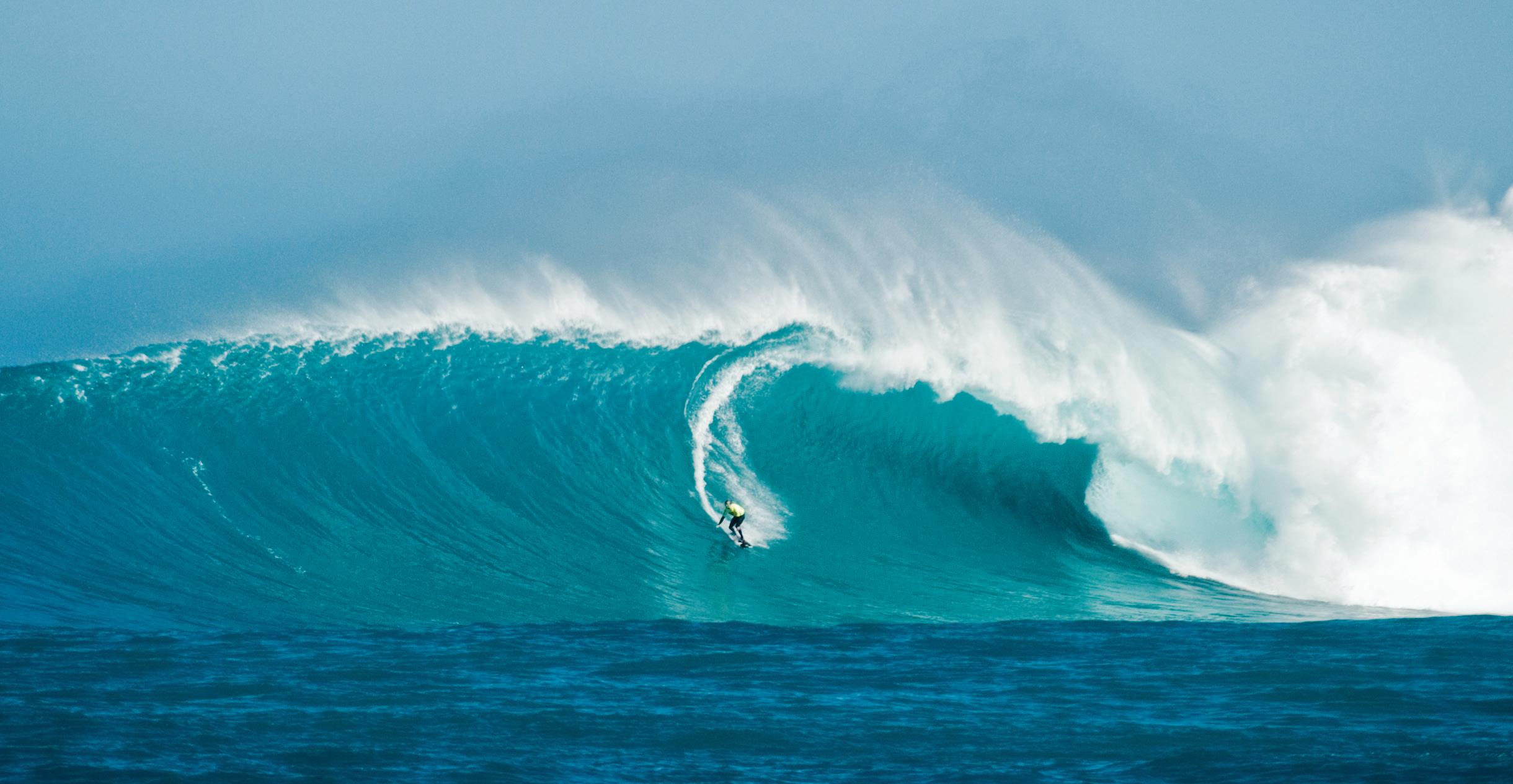
One is team. Specifically, that I get to collaborate with talented people inside and outside Ecco. The second is inventing the future. We don’t know what the future will be, but we have a hand in creating it. That opportunity and privilege is exciting. We’re at that moment with Ecco. There’s a new genera tion of global leadership—our new CEO, Panos Mytaros, is an insider but also a disruptor. He’s got a great vision for the company. We also have a family ownership that understands what this opportunity is. We think the world has changed, and we believe we’re as good as anyone at building shoes, and our mission is to deliver great casual shoes for the modern family. We don’t think there is anyone better positioned to do so. •

Q&A
continued from page 15
—TOM BERRY, PRESIDENT AND CEO, ECCO AMERICAS
COASTAL LIFE AT SURF EXPO Swim Boutique Resort Coastal Gift Souvenir Footwear Surf Bluewater Paddle Skate WATERSPORTS AT SURF EXPO REGISTER AT SURFEXPO.COM A Trade-Only Event. Qualified Retailers Attend for Free. Footwear for the beach, shore, boat, sidewalk, boardwalk and beyond.
Wholesale will be super important to us while, over the next three years, DTC will become significantly less important.
LAST SHOT The Fuchsia is Now
Hot Pink
The sweet-to-the-max Barbiecore trend holds its flavor for Spring ’23.
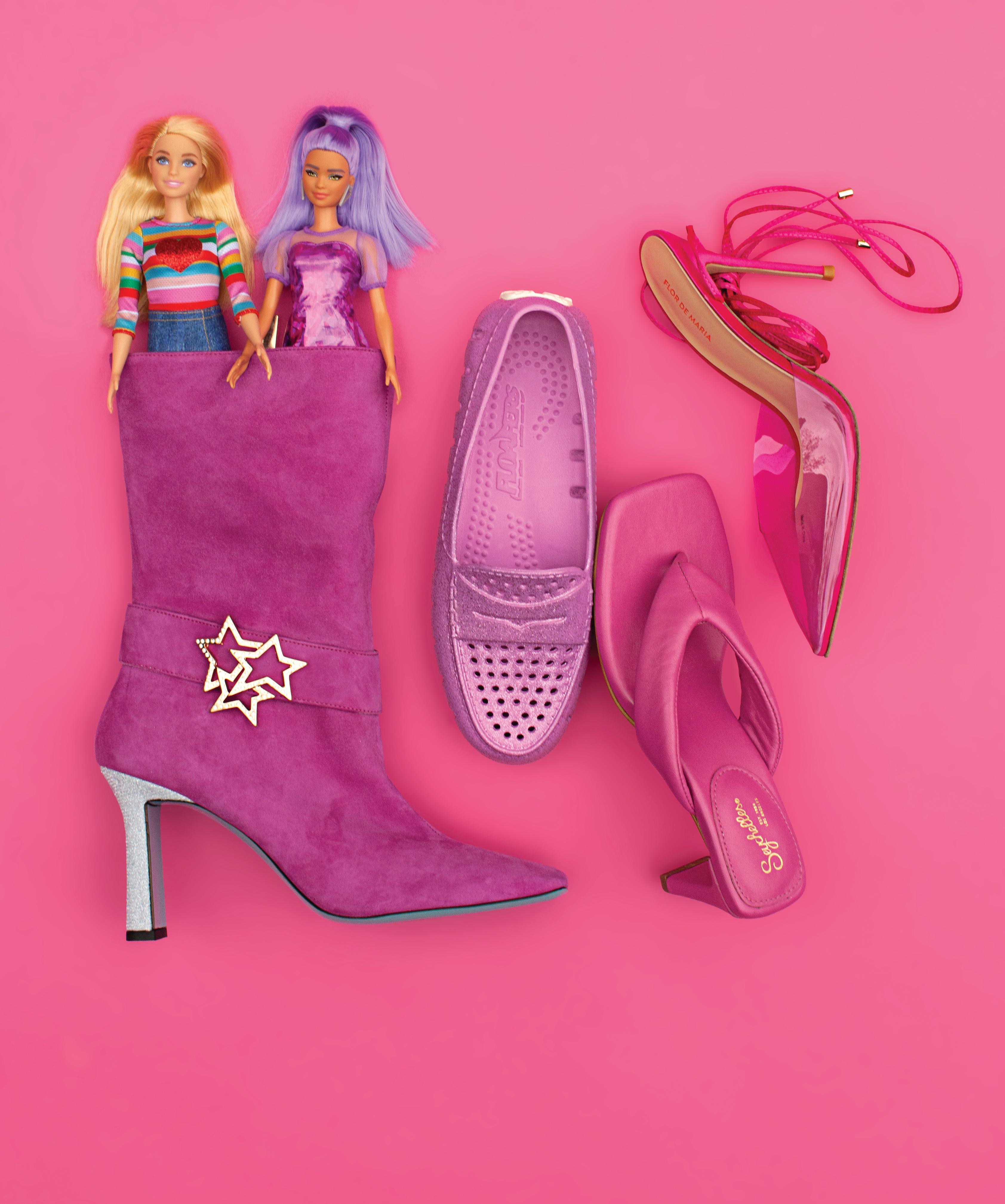
40 footwearplusmagazine.com • december 2022
PHOTOGRAPHY BY TREVETT MCCANDLISS
Valentina Rangoni
Floafers
Seychelles
Flor de Maria
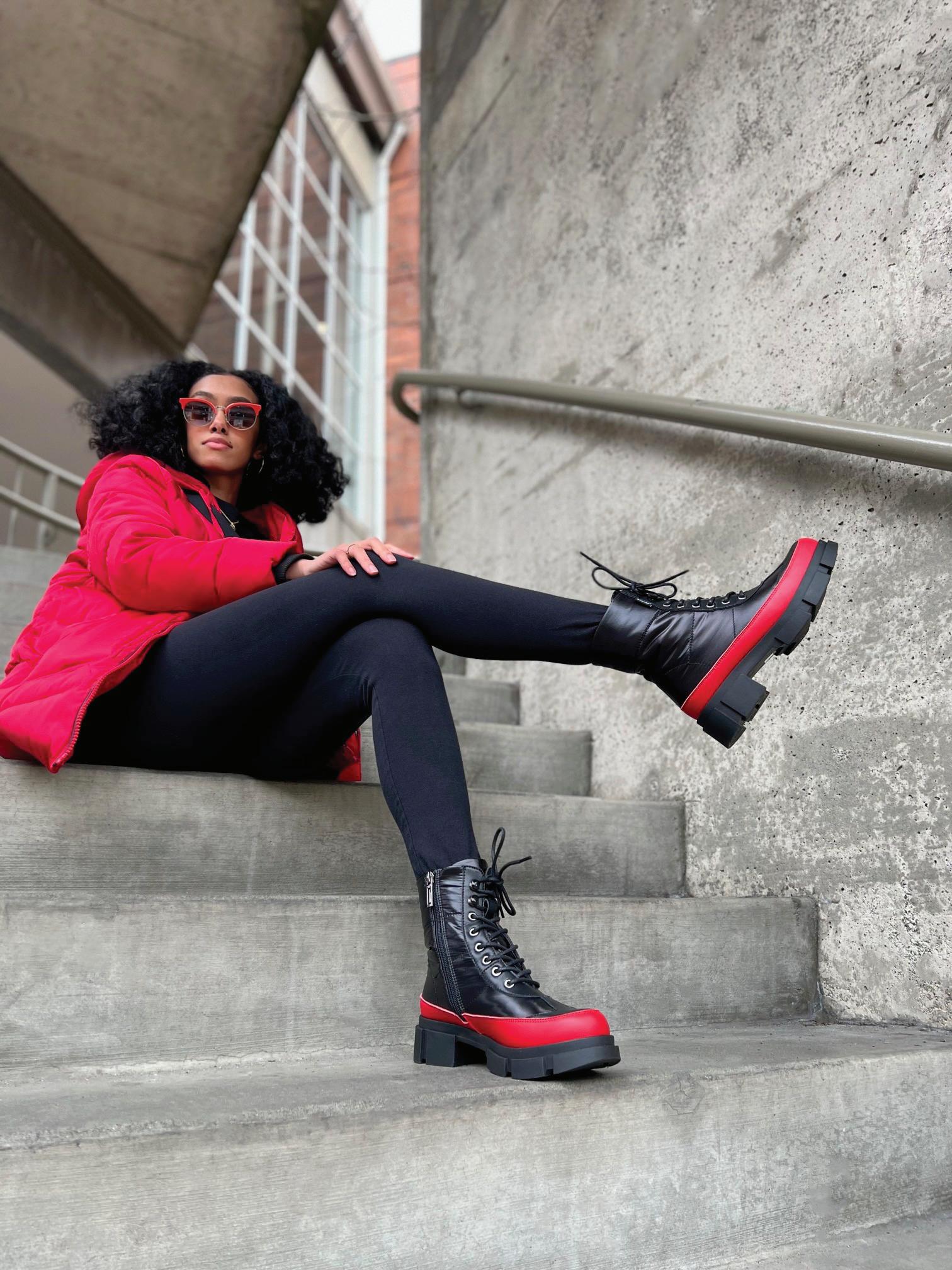
SALES@WASHINGTONSHOE.COM | SHOPCHOOKA.COM | 253.234.3000 STAY DRY AND STYLISH
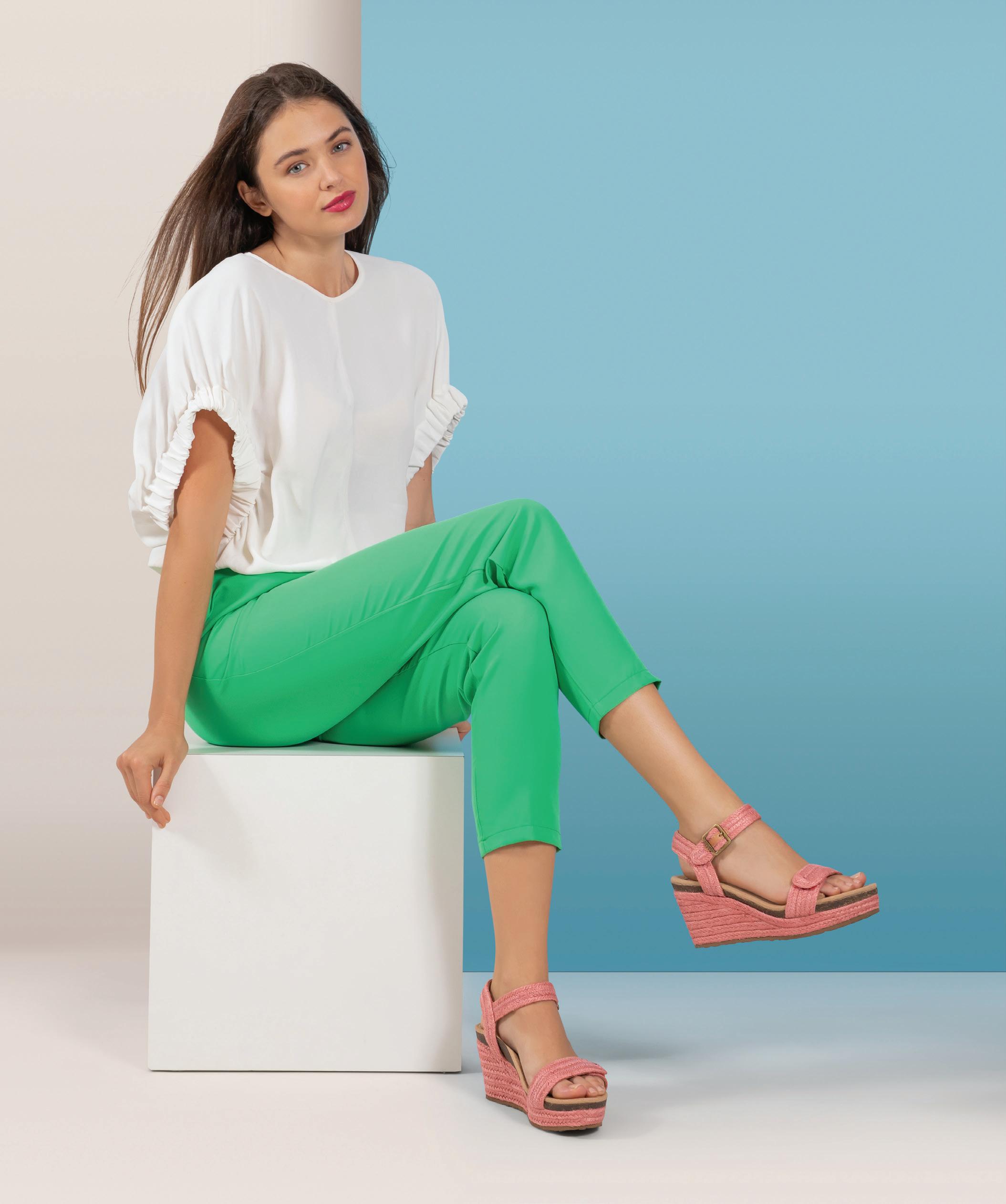 Featuring Aetrex orthotic support and memory foam cushioning for superior comfort
Featuring Aetrex orthotic support and memory foam cushioning for superior comfort




















 Clarks and the Clarks logo are registered trade marks of C. & J. Clark International Limited.
Clarks and the Clarks logo are registered trade marks of C. & J. Clark International Limited.


















































 Ron White
Taft
Wrangler
Spring Step
Ron White
Taft
Wrangler
Spring Step


 Seychelles chunky platforms.
Opposite: blush leather sandal by Patrizia
Seychelles chunky platforms.
Opposite: blush leather sandal by Patrizia
 Monde strappy minimal platform sandals. Opposite: metallic leather flatforms by Beautiisoles.
Monde strappy minimal platform sandals. Opposite: metallic leather flatforms by Beautiisoles.

 Peep toe platform sandal by Chinese Laundry Opposite: Aerosoles all-over blush suede block heel sandals.
Peep toe platform sandal by Chinese Laundry Opposite: Aerosoles all-over blush suede block heel sandals.


 Yvonne Koné lightweight wood clogs with stud details. Opposite: metallic gladiator flatform by Katy Perry
Yvonne Koné lightweight wood clogs with stud details. Opposite: metallic gladiator flatform by Katy Perry









 Featuring Aetrex orthotic support and memory foam cushioning for superior comfort
Featuring Aetrex orthotic support and memory foam cushioning for superior comfort





